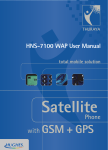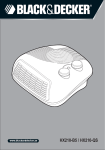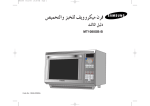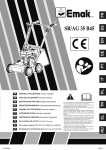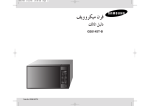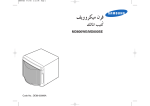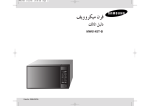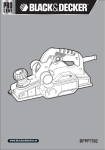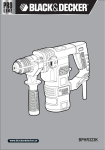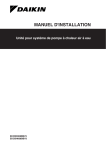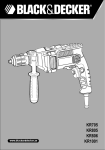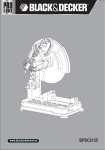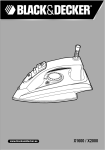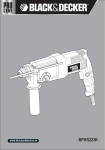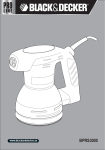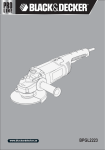Download Instruction Manual
Transcript
www.blackanddecker.ae BPRR1200 ENGLISH A 2 B ENGLISH C D E F 3 ENGLISH G H I J 4 ENGLISH K L M N 5 ENGLISH O 6 ENGLISH Intended use Your Black & Decker router has been designed for routing wood and wood products. This tool is intended for consumer use only. Safety instructions General power tool safety warnings Warning! Read all safety warnings and all instructions. Failure to follow the warnings and instructions listed below may result in electric shock, fire and/or serious injury. Save all warnings and instructions for future reference. The term "power tool" in all of the warnings listed below refers to your mains operated (corded) power tool or battery operated (cordless) power tool. 1. Work area safety a. Keep work area clean and well lit. Cluttered or dark areas invite accidents. b. Do not operate power tools in explosive atmospheres, such as in the presence of flammable liquids, gases or dust. Power tools create sparks which may ignite the dust or fumes. c. Keep children and bystanders away while operating a power tool. Distractions can cause you to lose control. 2. Electrical safety a. Power tool plugs must match the outlet. Never modify the plug in any way. Do not use any adapter plugs with earthed (grounded) power tools. Unmodified plugs and matching outlets will reduce risk of electric shock. b. Avoid body contact with earthed or grounded surfaces such as pipes, radiators, ranges and refrigerators. There is an increased risk of electric shock if your body is earthed or grounded. c. Do not expose power tools to rain or wet conditions. Water entering a power tool will increase the risk of electric shock. d. Do not abuse the cord. Never use the cord for carrying, pulling or unplugging the power tool. Keep cord away from heat, oil, sharp edges or moving parts. Damaged or entangled cords increase the risk of electric shock. e. When operating a power tool outdoors, use an extension cord suitable for outdoor use. Use of a cord suitable for outdoor use reduces the risk of electric shock. f. If operating a power tool in a damp location is unavoidable, use a residual current device (RCD) protected supply. Use of an RCD reduces the risk of electric shock. 3. Personal safety a. Stay alert, watch what you are doing and use common sense when operating a power tool. Do not use a power tool while you are tired or under the influence of drugs, alcohol or medication. A moment of inattention while operating power tools may result in serious personal injury. b. Use personal protective equipment. Always wear eye protection. Protective equipment such as dust mask, non-skid safety shoes, hard hat, or hearing protection used for appropriate conditions will reduce personal injuries. c. Prevent unintentional starting. Ensure the switch is in the off-position before connecting to power source and/or battery pack, picking up or carrying the tool. Carrying power tools with your finger on the switch or energising power tools that have the switch on invites accidents. d. Remove any adjusting key or wrench before turning the power tool on. A wrench or a key left attached to a rotating part of the power tool may result in personal injury. e. Do not overreach. Keep proper footing and balance at all times. This enables better control of the power tool in unexpected situations. f. Dress properly. Do not wear loose clothing or jewellery. Keep your hair, clothing and gloves away from moving parts. Loose clothes, jewellery or long hair can be caught in moving parts. g. If devices are provided for the connection of dust extraction and collection facilities, ensure these are connected and properly used. Use of dust collection can reduce dust-related hazards. 4. Power tool use and care a. Do not force the power tool. Use the correct power tool for your application. The correct power tool will do the job better and safer at the rate for which it was designed. b. Do not use the power tool if the switch does not turn it on and off. Any power tool that cannot be controlled with the switch is dangerous and must be repaired. 7 ENGLISH c. Disconnect the plug from the power source and/or the battery pack from the power tool before making any adjustments, changing accessories, or storing power tools. Such preventive safety measures reduce the risk of starting the power tool accidentally. d. Store idle power tools out of the reach of children and do not allow persons unfamiliar with the power tool or these instructions to operate the power tool. Power tools are dangerous in the hands of untrained users. Warning! Contact with, or inhalation of dusts arising from routing applications may endanger the health of the operator and possible bystanders. Wear a dust mask specifically designed for protection against dust and fumes and ensure that persons within or entering the work area are also protected. • Thoroughly remove all dust after routing. • Only use router bits with a shank diameter equal to the size of the collet installed in the tool. e. Maintain power tools. Check for misalignment or binding of moving parts, breakage of parts and any other condition that may affect the power tools operation. If damaged, have the power tool repaired before use. Many accidents are caused by poorly maintained power tools. • Only use router bits suitable for the no-load speed of the tool. • Never use router bits with a diameter exceeding the maximum diameter specified in the technical data section. • Do not use the tool in an inverted position. f. Keep cutting tools sharp and clean. Properly maintained cutting tools with sharp cutting edges are less likely to bind and are easier to control. • Do not attempt to use the tool in a stationary mode. • If the supply cord is damaged, it must be replaced by the manufacturer or an authorised Black & Decker Service Centre in order to avoid hazard. g. Use the power tool, accessories and tool bits etc., in accordance with these instructions, taking into account the working conditions and the work to be • performed. Use of the power tool for operations different from those intended could result in a hazardous situation. 5. Service a. Have your power tool serviced by a qualified repair person using only identical replacement parts. This will ensure that the safety of the power tool is maintained. Additional power tool safety warnings • Warning! Additional safety warnings for routers • Hold the power tool by the insulated gripping surfaces, because the cutter may contact its own cord. Cutting a "live" wire may make exposed metal parts of the power tool "live" and shock the operator. • Use clamps or another practical way to secure and support the workpiece to a stable platform. Holding the work by hand or against your body leaves it unstable and may lead to loss of control. 8 Take special care when routing where the paint is possibly lead based or when routing some woods which may produce toxic dust: - Do not let children or pregnant women enter the work area. - Do not eat, drink or smoke in the work area. - Dispose of dust particles and any other debris safely. The intended use is described in this instruction manual. The use of any accessory or attachment or performance of any operation with this tool other than those recommended in this instruction manual may present a risk of personal injury and/or damage to property. Safety of others • This appliance/tool is not intended for use by persons (including children) with reduced physical, sensory or mental capabilities, or lack of experience and knowledge, unless they have been given supervision or instruction concerning use of the appliance by a person responsible for their safety. ENGLISH • Children should be supervised to ensure that they do not play with the appliance. Residual risks. 3. Variable speed control knob 4. Plunge lock lever 5. Spindle lock button Additional residual risks may arise when using the tool which may not be included in the enclosed safety warnings. These 6. Collet risks can arise from misuse, prolonged use etc. 7. Revolver depth stop Even with the application of the relevant safety regulations and the implementation of safety devices, certain residual 8. Chip deflector risks can not be avoided. These include: 9. Depth stop bar • Injuries caused by touching any rotating/moving parts. 10. Depth of cut scale • Injuries caused when changing any parts, blades or accessories. • Injuries caused by prolonged use of a tool. When using any tool for prolonged periods ensure you take regular breaks. • Impairment of hearing. Fitting a router bit (fig. A) • Health hazards caused by breathing dust developed when using your tool (example:- working with wood, especially oak, beech and MDF.) • Remove the chip deflector (8). • Keep the spindle lock button (5) depressed and rotate the spindle until the spindle lock fully engages. • Loosen the collet nut (12) using the spanner provided. • Insert the shank of the router bit (13) into the collet (6). Make sure that the shank protrudes at least 3 mm from the collet as shown. Electrical safety • This tool is double insulated; therefore no earth wire is required. Always check that the power supply corresponds to the voltage on the rating plate. Keep the spindle lock button (5) depressed and tighten the collet nut (12) using the spanner provided. Fitting the edge guide (fig. B) Labels on tool The following pictograms are shown on the tool: 11. Dust extraction adaptor Assembly Warning! Before assembly, make sure that the tool is switched off and unplugged. Warning! To reduce the risk of injury, the user must read the instruction manual. • If the supply cord is damaged, it must be replaced by the manufacturer or an authorised Black & Decker Service Centre in order to avoid a hazard. Features 1. On/off switch 2. Lock-off button The edge guide helps to guide the tool parallel to an edge. • Fit the bars (14) to the edge guide (15) using the two screws (16) provided. • Insert the bars (14) into the router base as shown. • Set the edge guide to the required distance. • Tighten the fixing screws (17). 9 ENGLISH Fitting the dust extraction adaptor (fig. C) Adjusting the depth of cut (fig. H, I & J) The dust extraction adaptor allows you to connect a vacuum cleaner to the tool. The depth of cut is the distance X between the depth stop bar (9) and the depth stop (27). The depth of cut can be set in two different ways as described below. • Connect the hose (18) of the vacuum cleaner to the adaptor (11). Fitting the template guide (fig. D) • Fit the template guide (19) to the base of the router, with the flange to the bottom (workpiece) side. • Insert the two long screws (20) from the bottom side through the template guide and the holes in the base. • Place a nut onto each of the screws and securely tighten the nuts. Fitting the distance piece (fig. E) • Fit the distance piece (21) to the base of the router using the screws provided. Fitting the centring pin (fig. F) • Fit the edge guide to the router as shown in fig. B, but upside down. • Fit the centring pin (22) to the workpiece side of the edge guide with the screw (23) provided. Adjusting the depth of cut using the scale (fig. I) • Fit the router bit as described above. • Loosen the locking screw (28). • Pull the plunge lock lever (4) up. • Plunge the router down until the router bit touches the workpiece. • Push the plunge lock lever (4) down. • Move the pointer (29) in the zero position on the scale (10). • Add the desired depth of cut to the starting position. • Move the depth stop bar (9) to the calculated position on the scale. • Tighten the locking screw (28). • Fine adjust using the adjusting knob (30). • Pull the plunge lock lever (4) up and let the router return to its original position. • After switching the router on, plunge it down and make the desired cut. Fitting the copy follower (fig. G) • Fit the edge guide to the router as shown in fig. B. Adjusting the depth of cut using a piece of wood (fig. J) • Fit the ‘L' bar (24) to the upper side of the edge guide using the two screws and nuts provided. • Fit the router bit and plunge the router down as described above. • Adjust the rotating attachment (25) on the ‘L' bar with the wing knob (26). • Pull the depth stop bar (9) up. • Place a piece of wood with a thickness equal to the desired depth of cut between the depth stop (27) and the depth stop bar (9). • Tighten the locking screw (28). • Fine adjust using the adjusting knob (30). Use Warning! Let the tool work at its own pace. Do not overload. • Carefully guide the cable in order to avoid accidentally cutting it. 10 ENGLISH • Remove the piece of wood. Using the distance piece (fig. E) • Pull the plunge lock lever (4) up and let the router return to its original position. The distance piece can be used for trimming wooden or laminate vertical projections. • After switching the router on, plunge it down and make the desired cut. Using the centring pin (fig. F) Adjusting the revolver depth stop (fig. K) After turning the revolver depth stop to the desired setting, you can fine-adjust the depth stop to be used. If you want to make several cuts with a different depth of cut, adjust each of the depth stops. • Turn the depth stop screw (31) up or down as required using a screwdriver. Setting the speed • Set the speed control knob (3) to the required speed. Use a high speed for small diameter router bits. Use a low speed for large diameter router bits. Using a batten as a guide (fig. L) When it is not possible to use the edge guide, for example when routing grooves in the back panel of a bookcase to support shelves, proceed as follows: • Select a piece of wood with a straight edge to use as a batten. • Place the batten onto the workpiece. • Move the batten until it is in the correct position to guide the tool. • Securely clamp the batten to the workpiece. Using the template guide (fig. D) The centring pin can be used to cut out circular patterns. • Drill a hole for the point of the centring pin in the centre of the circle to be cut. • Place the router on the workpiece with the point of the centring pin in the drilled hole. • Adjust the radius of the circle with the bars of the edge guide. • The router can now be moved over the workpiece to cut out the circle. Using the copy follower (fig. G) The copy follower helps to maintain an equal cutting distance along the edge of irregularly shaped workpieces. • Place the router on the workpiece at the desired distance from the edge to be copied. • Adjust the bars of the edge guide until the wheel is in contact with the workpiece. Switching on and off Switching on • Keep the lock-off button (2) depressed and press the on/off switch (1). • Release the lock-off button. Switching off The template guide can be used to make a cutout shape from a template, for instance a letter. • • Warning! Always operate the tool with both hands. • Secure the template over the workpiece with double-sided tape or ‘G' clamps. The router bit must extend below the flange of the template guide, to cut the workpiece in the shape of the template. Release the on/off switch. Hints for optimum use • When working on outside edges, move the tool counterclockwise (fig. M). When working on inside edges, move the tool clockwise. 11 ENGLISH • Use HSS router bits for softwood. • Use TCT router bits for hardwood. • You can use the tool without a guide (fig. N). This is useful for signwriting and creative work. Only make shallow cuts. • Refer to the table below for common types of router bits. Router bits (fig. O) Description Application Straight bit (1) Grooves and rebates Trimming bit (2) Trimming laminates or hardwood; accurate profiling using a template Rebating bit (3) Rebates on straight or curved workpieces V-grooving bit (4) Grooves, engraving and edge bevelling Core box bit (5) Fluting, engraving and decorative edge moulding Cove bit (6) • Regularly clean the motor housing using a damp cloth. Do not use any abrasive or solvent-based cleaner. Accessories The performance of your tool depends on the accessory used. Black & Decker accessories are engineered to high quality standards and designed to enhance the performance of your tool. By using these accessories you will get the very best from your too Mains plug replacement (U.K. & Ireland only) If a new mains plug needs to be fitted: • Safely dispose of the old plug. • Connect the brown lead to the live terminal in the new plug. • Connect the blue lead to the neutral terminal. • Connect the green/yellow lead to the earth terminal. Warning! Follow the fitting instructions supplied with good quality plugs. Recommended fuse: 13 A. Technical data Decorative edge moulding BPRR1200 Ogee moulding bit (7) Decorative edge moulding Input voltage VAC 220-240 Rounding over bit (9) Rounding over edges Power input W 1,200 Dovetail bit (10) Dovetail joints Chamfer bit (11) Chamfer edges No-load speed /min Collet size 8,000 - 27,000 5/16" (8 mm) / 1/4" (6.35 mm) / 6 mm Max. diameter of router bit mm 30 Maintenance Max. depth of cut mm 55 Your tool has been designed to operate over a long period of time with a minimum of maintenance. Continuous satisfactory operation depends upon proper tool care and regular cleaning. Weight kg 3.6 Warning! Before performing any maintenance, switch off and unplug the tool. • Regularly clean the ventilation slots in your tool using a soft brush or dry cloth. 12 ENGLISH Protecting the environment Guarantee Separate collection. This product must not be disposed of with normal household waste. Black & Decker is confident of the quality of its products and offers an outstanding guarantee. This guarantee statement is Should you find one day that your Black & Decker in addition to and in no way prejudices your statutory rights. product needs replacement, or if it is of no further use to you, The guarantee is valid within the territories of the Member do not dispose of it with household waste. Make this product States of the European Union and the European Free Trade Area. available for separate collection. Separate collection of used products and packaging allows materials to be recycled and used again. Reuse of recycled materials helps prevent environmental pollution and reduces the demand for raw materials. Local regulations may provide for separate collection of electrical products from the household, at municipal waste sites or by the retailer when you purchase a new product. Black & Decker provides a facility for the collection and recycling of Black & Decker products once they have reached the end of their working life. To take advantage of this service please return your product to any authorised repair agent who will collect them on our behalf. You can check the location of your nearest authorised repair agent by contacting your local Black & Decker office at the address indicated in this manual. Alternatively, a list of authorised Black & Decker repair agents and full details of our after-sales service and contacts are available on the Internet at: www.2helpU.com. If a Black & Decker product becomes defective due to faulty materials, workmanship or lack of conformity, within 12 months from the date of purchase, Black & Decker guarantees to replace defective parts, repair products subjected to fair wear and tear or replace such products to make sure of the minimum inconvenience to the customer unless: • The product has been used for trade, professional or hire purposes. • The product has been subjected to misuse or neglect. • The product has sustained damage through foreign objects, substances or accidents. • Repairs have been attempted by persons other than authorised repair agents or Black & Decker service staff. To claim on the guarantee, you will need to submit proof of purchase to the seller or an authorised repair agent. You can check the location of your nearest authorised repair agent by contacting your local Black & Decker office at the address indicated in this manual. Alternatively, a list of authorised Black & Decker repair agents and full details of our aftersales service and contacts are available on the Internet at: www.2helpU.com Please visit our website www.blackanddecker.co.uk to register your new Black & Decker product and to be kept up to date on new products and special offers. Further information on the Black & Decker brand and our range of products is available at www.blackanddecker.co.uk. 13 FRANÇAIS A 14 B FRANÇAIS C D E F 15 FRANÇAIS G H I J 16 FRANÇAIS K L M N 17 FRANÇAIS O 18 FRANÇAIS Utilisation prévue Votre raboteuse Black & Decker a été conçue pour raboter le bois, les produits du bois et les plastiques. Cet outil a été conçu pour une utilisation manuelle et exclusivement domestique. Consignes de sécurité Consignes de sécurité concernant les outils électroportatifs blessures. Attention ! Lisez avec attention tous les avertissements et toutes les instructions. Le non-respect de cette consigne peut entraîner une électrocution, un incendie et/ou de graves Conservez tous les avertissements et instructions pour référence ultérieure. La notion d’ « outil électroportatif » mentionnée par la suite se rapporte à des outils électriques raccordés au secteur (avec câble de raccordement) ou fonctionnant avec batterie (sans fil). 1. Sécurité de la zone de travail a. Maintenez la zone de travail propre et bien éclairée. Un lieu de travail en désordre ou mal éclairé augmente le risque d’accidents. b. N’utilisez pas les outils électroportatifs dans un environnement présentant des risques d’explosion, ni en présence de liquides, gaz ou poussières inflammables. Les outils électroportatifs génèrent des étincelles risquant d’enflammer les poussières ou les vapeurs. c. Pendant l’utilisation d’un outil électroportatif, les enfants et autres personnes doivent rester éloignés. En cas d’inattention, vous risquez de perdre le contrôle de l’outil. 2. Sécurité électrique a. La prise de l’outil électroportatif doit convenir à la prise de courant. Ne modifiez en aucun cas la prise. N’utilisez pas de prises d’adaptateur avec des outils ayant une prise de terre. Le respect de ces consignes réduit le risque de choc électrique. b. Évitez le contact physique avec des surfaces mises à la terre telles que tuyaux, radiateurs, fours et réfrigérateurs. Le risque de choc électrique augmente si votre corps est relié à la terre. c. N’exposez pas l’outil électroportatif à la pluie ni à l’humidité. La pénétration d’eau dans un outil électroportatif augmente le risque de choc électrique. d. Préservez le câble d’alimentation. N’utilisez pas le câble pour porter l’outil, pour l’accrocher ou encore pour le débrancher. Maintenez le câble éloigné des sources de chaleurs, des parties huilées, des bords tranchants ou des parties de l’outil en rotation. Le risque de choc électrique augmente si les câbles sont endommagés ou emmêlés. e. Si vous utilisez l’outil électroportatif à l’extérieur, utilisez une rallonge homologuée pour utilisation à l’air libre. L’utilisation d’une rallonge électrique homologuée pour les travaux à l’extérieur réduit le risque de choc électrique. f. Si l’outil doit être utilisé dans un endroit humide, prenez les précautions nécessaires en utilisant un dispositif à courant résiduel (RCD). L’utilisation d’un tel dispositif réduit les risques d’électrocution. 3. Sécurité personnelle a. Restez vigilant, surveillez ce que vous faites. Faites preuve de bon sens quand vous utilisez un outil électroportatif. N’utilisez pas l’outil lorsque vous êtes fatigué ou après avoir consommé de l’alcool ainsi que des médicaments. Un moment d’inattention lors de l’utilisation de l’outil peut entraîner de graves blessures. b. Portez un équipement de protection. Portez toujours des lunettes de protection. Selon le travail à effectuer, le port d’équipement de protection tels que masque anti-poussières, chaussures de sécurité antidérapantes, casque ou protection auditive, réduit le risque de blessures. c. Évitez un démarrage imprévu. L’outil doit être en position OFF (arrêt) avant d’effectuer le branchement à l’alimentation et/ou au bloc-batterie, de le ramasser ou de le porter. Ne laissez pas votre doigt sur le bouton de commande, ceci peut être à l’origine d’accidents. d. Retirez tout outil ou clé de réglage avant de mettre l’outil en marche. Une clé ou un outil se trouvant sur une partie en rotation peut causer des blessures. e. Adoptez une position confortable. Adoptez une position stable et gardez votre équilibre en permanence. Vous contrôlerez ainsi mieux l’outil dans des situations inattendues. f. Portez des vêtements appropriés. Ne pas porter de vêtements amples ou de bijoux. N’approchez pas les cheveux, vêtements ou gants des parties des pièces mobiles. Les vêtements amples, les bijoux ou les cheveux longs peuvent se prendre dans les pièces en mouvement. g. En cas d’utilisation d’appareils servant à aspirer ou à recueillir les poussières, assurez-vous qu’ils sont correctement raccordés et utilisés. L’utilisation de tels appareils permet de réduire les dangers liés aux poussières. 4. Utilisation des outils électroportatifs et précautions a. Respectez la capacité de l’outil. Utilisez l’outil électroportatif approprié pour le travail à effectuer. Avec un outil approprié, vous travaillerez mieux et en toute sécurité. 19 FRANÇAIS b. N’utilisez pas un outil électroportatif dont le bouton marche/arrêt est défectueux. Un outil électroportatif qui ne peut plus être mis en marche ou arrêté est dangereux • et doit être réparé. c. Retirez la prise de courant et/ou débranchez le bloc-batterie avant d’effectuer des réglages, de changer les accessoires ou de ranger l’outil. Cette mesure de précaution empêche de mettre l’outil en marche accidentellement. d. Rangez les outils électroportatifs hors de portée des enfants. Les personnes ne connaissant pas l’outil ou n’ayant pas lu ces instructions ne doivent en aucun cas l’utiliser. Les outils électroportatifs sont dangereux lorsqu’ils sont utilisés par des personnes non initiées. g. Utilisez l’outil électrique, les accessoires et les forets, etc., conformément aux présentes directives et en tenant compte des conditions de travail et du travail à effectuer. L’utilisation d’un outil électrique à d’autres fins que celles prévues peut entraîner des situations dangereuses. • Tenez l’outil uniquement par les surfaces isolées des poignées car l’opération effectuée peut mettre le couteau en contact avec son propre câble. En coupant un fil sous tension, les parties métalliques 20 N’utilisez que des fraises ayant un diamètre de tige égal à la taille de la pince installée sur l’outil. N’utilisez que des fraises adaptées à la vitesse à vide de l’outil. N’utilisez jamais de fraises dont le diamètre est supérieur au diamètre maximum indiqué au paragraphe des données techniques. N’utilisez pas l’outil en position inversée. • Ne tentez pas d’utiliser l’outil en position fixe. • Si le câble d’alimentation est endommagé, il doit être remplacé par le fabricant ou par un centre de réparation agréé Black & Decker afin d’éviter tout accident. • Faites particulièrement attention lorsque vous fraisez de la peinture pouvant être à base de plomb ou lorsque vous fraisez du bois pouvant produire de la poussière toxique : - Ne laissez pas les enfants et les femmes enceintes entrer dans la zone de travail. a. Faites réparer votre outil électroportatif uniquement par du personnel qualifié et seulement avec des pièces de rechange appropriées. La fiabilité de l’outil sera ainsi maintenue. Attention! Consignes de sécurité supplémentaires pour les raboteuses Enlevez soigneusement toute poussière après le fraisage. • 5. Réparations Consignes de sécurité supplémentaires pour les outils électriques Utilisez des pinces ou autres pour fixer et soutenir la pièce de manière stable. Si vous la tenez à la main ou contre votre corps, elle ne sera pas stable et vous pouvez en perdre le contrôle. Attention! L’inhalation ou le contact avec les poussières de fraisage peuvent mettre en danger la santé de l’opérateur ou des observateurs. Portez un masque anti-poussière spécialement conçu pour la protection contre la poussière et les émanations et assurez-vous que les personnes se trouvant à l’intérieur de la zone de travail ou y pénétrant soient également protégés. • e. Prenez soin des outils électroportatifs. Vérifiez que les parties en mouvement fonctionnent correctement • et qu’elles ne sont pas coincées. Vérifiez qu’il n’y a pas de pièces cassées ou endommagées susceptibles de nuire au bon fonctionnement de • l’outil. S’il est endommagé, faites réparer l’outil avant de l’utiliser. De nombreux accidents sont la • conséquence d’outils mal entretenus. f. Maintenez les outils de coupe aiguisés et propres. Des outils soigneusement entretenus avec des bords tranchants bien aiguisés se coincent moins souvent et peuvent être guidés plus facilement. exposées de l’outil seraient électrifiées, exposant l’opérateur à un risque de choc électrique. - Ne mangez pas, ne buvez pas et ne fumez pas dans la zone de travail. - Disposez de façon sécuritaire des particules de poussière et autres débris. • Ce manuel d’instructions décrit comment utiliser cet appareil. • L’utilisation d’un accessoire ou d’une fixation, ou l’utilisation de cet appareil à d’autres fins que celles recommandées dans ce manuel d’instructions peut entraîner des blessures et/ou des dommages matériels. FRANÇAIS Sécurité pour autrui Caractéristiques • Cet outil ne peut être utilisé par des personnes (y compris des enfants) ayant des capacités mentales, sensorielles ou physiques réduites, ou celles manquant d’expérience et de connaissances, à moins qu’elles ne soient encadrées ou qu’elles n’aient été formées à l’utilisation de l’outil par une personne responsable de leur sécurité. 1. Interrupteur marche/arrêt Ne laissez jamais les enfants sans surveillance pour éviter qu’ils ne jouent avec cet outil. 5. Bouton de blocage de l’axe • Risques résiduels. 2. Bouton de blocage 3. Variateur de vitesse 4. Levier de blocage en plongée 6. Pince Des risques résiduels supplémentaires pouvant survenir lors de l’utilisation d’un outil, peuvent ne pas être mentionnés dans les présentes règles de sécurité. Ces risques peuvent découler d’une mauvaise utilisation, d’une utilisation prolongée de l’outil, etc. Même en respectant les consignes de sécurité applicables et en utilisant des dispositifs de sécurité, certains risques résiduels ne peuvent pas être évités. Sont inclus: 7. Butée de profondeur revolver • Blessures causées en touchant les parties mobiles ou en rotation. Assemblage • Blessures causées lors du changement de pièces, de lames ou d’accessoires. • Blessures causées par l’utilisation prolongée d’un outil. Si vous devez utiliser un outil pendant de longues périodes, pensez à prendre des pauses régulièrement. • Troubles auditifs. • Risques pour la santé causés par l’inhalation de poussières dégagées lors de l’utilisation de votre outil (exemple:- travail du bois, surtout le chêne, l’hêtre et le MDF.) Etiquettes apposées sur l’outil Les pictogrammes suivants sont affichés sur l’outil: Attention! Pour réduire le risque de blessure, l’utilisateur doit lire les instructions du manuel. Sécurité électrique Cet outil est doublement isolé; par conséquent, aucun câble de mise à la terre n’est nécessaire. Vérifiez bien que la tension secteur correspond à celle indiquée sur la plaque signalétique. • Si le câble d’alimentation est endommagé, il doit être remplacé par le fabricant, par un centre de réparation Black & Decker agréé de façon à éviter tout danger. 8. Déflecteur de sciures 9. Barre de butée de profondeur 10. Echelle de profondeur de coupe 11. Adaptateur d’extraction de poussière Attention! Avant l’assemblage, assurez-vous que l’outil est éteint et débranché. Mise en place d’une fraise (fig. A) • Retirez le déflecteur de sciures (8). • Tout en maintenant le bouton de blocage de l’axe (5) enfoncé, faites tourner l’axe jusqu’à ce que le bouton de blocage de l’axe s’engage complètement. • Dévisser l’écrou de la pince (12) à l’aide de la clé fournie. • Insérez la tige de la fraise (13) dans la pince (6). Vérifiez que la tige dépasse d’au moins 3 mm de la pince comme illustré. • Tout en maintenant le bouton de blocage de l’axe (5) enfoncé, serrez l’écrou de la pince (12) avec la clé fournie. Mise en place du sabot de guidage (fig. B) Le sabot de guidage vous aide à guider l’outil pour qu’il travaille parallèlement à un bord. • Fixez les barres (14) au sabot de guidage (15) à l’aide des deux vis (16) fournies. • Insérez les barres (14) dans la base de la fraiseuse comme illustré. • Réglez le sabot de guidage à la distance voulue. 21 FRANÇAIS • Serrez les vis de fixation (17). Mise en place de l’adaptateur d’extraction de poussière (fig. C) L’adaptateur d’extraction de poussière vous permet de brancher un aspirateur sur l’outil. • Montez l’adaptateur (11) sur le tuyau (18) de l’aspirateur. Réglage de la profondeur de coupe (fig. H, I & J) La profondeur de coupe est égale à la distance X entre la barre de butée de profondeur (9) et la butée de profondeur (27). La profondeur de coupe est réglable de deux manières, qui sont décrites ci-après. Réglage de la profondeur de coupe l’aide de l’échelle (fig. I) Mise en place du guide de gabarit (fig. D) • Installez la fraise comme indiqué ci-dessus. • • Desserrez la vis de blocage (28). • Tirez sur le levier de blocage en plongée (4). • Rabaissez la fraiseuse jusqu’à ce que la fraise entre en contact avec la pièce à travailler. • Poussez sur le levier de blocage en plongée (4). • Déplacez le pointeur (29) sur la position zéro de l’échelle de coupe (10). • Ajoutez la profondeur de coupe souhaitée à la position de départ. • Déplacez la barre de butée de profondeur (9) sur la position calculée sur l’échelle. • Serrez la vis de blocage (28). • Un réglage précis est possible à l’aide du bouton de réglage (30). • Tirez sur le levier de blocage en plongée (4) et laissez la fraiseuse revenir sur sa position initiale. • Allumez la fraiseuse, abaissez-la et effectuez la coupe voulue. Installez le guide de gabarit (19) sur la base de la fraiseuse, en prenant soin de placer la bride vers le bas (pièce à ouvrer). • Insérez les deux vis longues (20) par dessous dans le guide de gabarit et les trous de la base. • Placez un écrou sur chacune de ces vis et serrez-les bien. Mise en place de la pièce intercalaire (fig. E) • Fixez la pièce intercalaire (21) sur le bas de la fraiseuse à l’aide des vis fournies. Mise en place de la goupille de centrage (fig. F) • Placez le sabot de guidage sur la fraiseuse comme illustré dans la fig. B, mais dans le sens inverse. • Fixez la goupille de centrage (22) du sabot de guidage côté pièce à travailler à l’aide de la vis (23) fournie. Mise en place du suiveur de copie (fig. G) • Placez le sabot de guidage sur la fraiseuse comme illustré dans la fig. B. • Fixez la barre en ‘L' (24) sur le côté supérieur du sabot de guidage à l’aide des deux vis et des écrous fournis. • Réglez l’accessoire rotatif (25) sur la barre en ‘L' à l’aide de la vis papillon (26). Utilisation Attention! Laissez l’outil fonctionner à sa propre vitesse. Ne le surchargez pas. • Guidez le câble avec soin pour éviter de le couper par mégarde. 22 Réglage de la profondeur de coupe à l’aide d’un morceau de bois (fig. J) • Insérez la fraise et abaissez la fraiseuse comme décrit précédemment. • Levez la barre de butée de profondeur (9). • Placez un morceau de bois d’une épaisseur égale à la profondeur de coupe voulue entre la butée de profondeur (27) et la barre de butée de profondeur (9). • Serrez la vis de blocage (28). • Un réglage précis est possible à l’aide du bouton de réglage (30). FRANÇAIS • Enlevez le morceau de bois. Utilisation de la pièce intercalaire (fig. E) • Tirez sur le levier de blocage en plongée (4) et laissez la fraiseuse revenir sur sa position initiale. La pièce intercalaire peut servir à ébarber des projections verticales dans du bois ou du stratifié. • Allumez la fraiseuse, abaissez-la et effectuez la coupe voulue. Utilisation de la goupille de centrage (fig. F) Réglage de la butée de profondeur revolver (fig. K) La goupille de centrage peut servir à découper des formes circulaires. Après avoir tourné la butée de profondeur revolver sur le réglage voulu, vous pouvez effectuer un réglage précis de la butée de profondeur à utiliser. Si vous souhaitez effectuer plusieurs coupes de différentes profondeurs, réglez chacune des butées de profondeur. • Percez un trou pour repérer la place de la goupille de centrage au centre du cercle à découper. • Placez la fraiseuse sur la pièce en plaçant la pointe de la goupille de centrage dans le trou percé au préalable. • • Réglez le rayon du cercle à l’aide des barres du sabot de guidage. • Vous pouvez maintenant déplacer la fraiseuse sur la pièce pour découper un cercle. Tournez la vis de butée de profondeur (31) dans un sens ou dans l’autre, selon les besoins, à l’aide d’un tournevis. Réglage de la vitesse • Ajustez la vitesse souhaitée à l’aide du variateur de vitesse (3). Choisissez une vitesse élevée pour les fraises de petit diamètre. Choisissez une vitesse faible pour les fraises de grand diamètre. Utilisation d’une latte de guidage (fig. L) Lorsqu’il n’est pas possible d’utiliser un sabot de guidage, comme par exemple lorsque vous taillez des rainures sur le panneau arrière d’un meuble à étagères, procédez comme suit: Utilisation du suiveur de copies(fig. G) Le suiveur de copie vous permet de préserver une distance de coupe égale le long du bord des pièces de formes irrégulières. . • Placez la fraiseuse sur la pièce à la distance souhaitée par rapport au bord à copier. • Réglez les barres du sabot de guidage jusqu’à ce que la roulette soit bien en contact avec la pièce. Démarrage et arrêt • Sélectionnez un morceau de bois avec un bord droit pour servir de latte de guidage. • Placez la latte sur la pièce à travailler. • • Déplacez la latte sur la position qui convient pour guider l’outil. Appuyez sur le bouton de blocage (2) maintenez le enfoncé et appuyez sur l’interrupteur marche/arrêt (1). • Relâchez le bouton de blocage. Attachez solidement la latte sur la pièce à travailler. Arrêt • Démarrage Utilisation du guide de gabarit (fig. D) • Le guide de gabarit peut servir à découper une forme dans un gabarit, une lettre par exemple. Attention! Tenez toujours l’outil avec les deux mains. • Fixez le gabarit sur la pièce à travailler à l’aide d’adhésif double face ou des pinces en ‘G'. • La fraise doit passer sous la bride du guide de gabarit pour découper dans la pièce la forme du gabarit.. Relâchez l’interrupteur marche/arrêt. Conseils pour une utilisation optimale • Lorsque vous travaillez sur des bords externes, déplacez l’outil dans le sens antihoraire (fig. M). lorsque vous travaillez sur des bords internes, déplacez l’outil dans le sens horaire. 23 FRANÇAIS • Utilisez des fraises HSS pour le bois tendre. • Utilisez des fraises TCT pour le bois dur. • Vous pouvez utiliser l’outil sans guidage (fig. N). Ceci vous permet d’effectuer des travaux d’écriture et des motifs. Ne faites que des coupes peu profondes. • Reportez-vous au tableau ci-dessous pour consulter les modèles habituels de fraises. Fraises (fig. O) Description Application Nettoyez régulièrement le boîtier du moteur avec un chiffon humide. N’utilisez pas de produits abrasifs ou à base de solvants. Accessoires La performance de votre outil dépend des accessoires que vous utilisez. Les accessoires Black & Decker sont conçus selon des normes de qualité supérieure pour améliorer les performances de votre outil. En utilisant ces accessoires, vous obtiendrez le meilleur de votre outil Remplacement d’une fiche secteur (Royaume Uni & Irlande uniquement) Fraise droite (1) Rainures et encoches Fraise à ébarbage (2) Ebarbage des bois durs ou stratifiés; profilage précis avec un gabarit Si une nouvelle fiche secteur doit être raccordée: • Jetez l’ancienne fiche de façon sécuritaire. Fraise à encoches (3) Encoches sur des pièces en bois droites ou cintrées • Branchez le fil marron à la borne sous tension de la nouvelle fiche. Fraise à rainure en V (4) Rainures, gravure et biseautage des bords • Branchez le fil bleu à la borne neutre. Fraise à canneler (5) Cannelure, gravure et moulurage de bords décoratifs • Branchez le fil vert/jaune à la borne terre. Fraise à gorge (6) Moulurage de bords décoratifs Fraise à doucine (7) Moulurage de bords décoratifs Fraise à arrondi (9) Arrondissage des bords Fraise pour queue d’aronde (10) Assemblage à queue d’aronde Fraise à chanfreiner (11) Bords en biseau Entretien Votre outil a été conçu pour fonctionner sur une longue période de temps avec un minimum d’entretien. Un fonctionnement continu satisfaisant dépend d’un nettoyage et d’un entretien soigneux et régulier. Attention! Avant d’effectuer tout entretien, éteignez et débranchez l’outil. • • Nettoyez régulièrement les fentes de ventilation de votre outil à l’aide d’une brosse souple ou d’un chiffon sec. 24 Suivez les instructions de montage fournies avec les fiches secteur de bonne qualité. Fusible recommandé: 13 A. Données techniques BPRR1200 Tension d’entrée Puissance nominale Vitesse à vide VAC 220-240 W 1200 /min Pince de serrage (taille) 8,000 - 27,000 5/16" (8 mm) / 1/4" (6.35 mm) / 6 mm Diamètre max. de la fraise mm Profondeur max.de coupe mm 55 kg 3,6 Poids 30 FRANÇAIS Protection de l'environnement Recyclage. Cet appareil ne doit pas être jeté avec les déchets ménagers. Si votre appareil Black & Decker doit être remplacé ou si vous n'en avez plus l'usage, ne le jetez pas avec les ordures ménagères. Songez à la protection de l'environnement et recyclez-les. La collecte séparée des produits et des emballages usagés permet de recycler et de réutiliser des matériaux. La réutilisation de matériaux recyclés évite la pollution de l'environnement et réduit la demande de matières premières. Des réglementations locales peuvent stipuler la collecte séparée des produits électriques et des produits ménagers, dans des déchetteries municipales ou par le revendeur lorsque vous achetez un nouveau produit. Black & Decker offre une solution permettant de recycler les produits Black & Decker lorsqu'ils ont atteint la fin de leur cycle de vie. Pour pouvoir profiter de ce service, veuillez retourner votre produit à un réparateur agréé qui se chargera de le collecter pour nous. Garantie Black & Decker vous assure la qualité de ses produits et vous offre une garantie très étendue. Ce certificat de garantie est un document supplémentaire et ne peut en aucun cas se substituer à vos droits légaux. La garantie est valable sur tout le territoire des États Membres de l'Union Européenne et de la Zone de Libre Échange Européenne. Si un produit Black & Decker s'avère défectueux en raison de matériaux en mauvais état, d'une erreur humaine, ou d'un manque de conformité dans les 12 mois suivant la date d'achat, Black & Decker garantit le remplacement des pièces défectueuses, la réparation des produits usés ou cassés ou remplace ces produits à la convenance du client, sauf dans les circonstances suivantes : • Le produit a été utilisé dans un but commercial, professionnel, ou a été loué. • Le produit a été mal utilisé ou avec négligence. • Le produit a subi des dommages à cause de corps étrangers, de substances ou d'accidents. • Des réparations ont été tentées par des techniciens ne Pour connaître l'adresse du réparateur agréé le plus proche faisant pas partie du service technique de Black & de chez vous, contactez le bureau Black & Decker à Decker. l'adresse indiquée dans ce manuel. Vous pourrez aussi trouver une liste de réparateurs agréés de Black & Decker et Pour avoir recours à la garantie, il est nécessaire de fournir de plus amples détails sur notre service après-vente sur le une preuve d'achat au vendeur ou à un réparateur agréé. site Internet à l'adresse suivante : www.2helpU.com. Pour connaître l'adresse du réparateur agréé le plus proche de chez vous, contactez le bureau Black & Decker à l'adresse indiquée dans ce manuel. Vous pourrez aussi trouver une liste de réparateurs agréés de Black & Decker et de plus amples détails sur notre service après-vente sur le site Internet à l'adresse suivante : www.2helpU.com Visitez notre site Web www.blackanddecker.eu pour enregistrer votre nouveau produit Black & Decker et être informé des nouveaux produits et des offres spéciales. Pour plus d'informations concernant la marque Black & Decker et notre gamme de produits, consultez notre site www.blackanddecker.eu. 25 Arabic ¿Éª°†dG ¿É«H ¿ƒµjh .kGõ«‡ Ék fɪ°V Ωó≤Jh É¡JÉéàæe IOƒéH ôµjO ófBG ∑ÓH ≥ãJ ¥ƒ≤◊ÉH ∫GƒMC’G øe ∫ÉM …CÉH πîj ’h áaÉ°VE’ÉH Gòg ¿Éª°†dG OÉ–E’G ‘ AÉ°†YC’G ∫hódG º«∏bEG πNGO ¿Éª°†dG Gòg …öùjh .á«fƒfÉ≤dG .á«HhQhC’G Iô◊G IQÉéàdG á≤£æeh »HhQhC’G áÄ«ÑdG ájɪM ™e èàæŸG Gòg AÉ≤dEG ΩóY Öéj .π°üØæe ™«ªŒ .á«dõæŸG äÉØ∏îŸG ófBG ∑ÓH RÉ¡L πjóÑJ Öéj ¬fCÉH ΩÉjC’G óMCG ‘ ∂d ÚÑJ GPEG ¢ü∏îàJ ’ .¬eGóîà°S’ áLÉëH ó©J ⁄ hCG ∂H ¢UÉÿG ôµjO áYÉæ°üdGh OGƒŸG ܃«Y ÖÑ°ùH Ék Ñ«©e ôµjO ófBG ∑ÓH èàæe íÑ°UCG GPEG ™«ªéà∏d èàæŸG Gòg ÒaƒàH ºbh .á«dõæŸG äÉØ∏îŸG ™e ¬æe ïjQÉJ øe kGô¡°T 12 ¿ƒ°†Z ‘ ôµjO ófBG ∑ÓH øª°†J ,á≤HÉ£ŸG ΩóYh .π°üØæŸG »∏ÑdG IÉYGôe ™e äÉéàæŸG ìÓ°UEGh áÑ«©ŸG AGõLC’G ∫GóÑà°SG AGöûdG AÓª©dG É°VQ øe ócCÉà∏d äÉéàæŸG √òg ∫GóÑà°SG hCG …OÉ©dG ΩGóîà°S’ÉH :⁄ Ée äGƒÑ©dGh äÉéàæª∏d π°üØæŸG ™«ªéàdG øµÁ É¡eGóîà°SGh OGƒŸG ôjhóJ IOÉYEG øe áeóîà°ùŸG ÉgôjhóJ OÉ©ŸG OGƒŸG ΩGóîà°SG IOÉYEG óYÉ°ùj PEG ,iôNCG Iôe .ÒLCÉà∏d hCG á«æ¡e hCG ájQÉŒ ¢VGôZC’ èàæŸG ΩGóîà°SG ” • ΩÉÿG OGƒŸG ≈∏Y Ö∏£dG ¢†ØNh »Ä«ÑdG çƒ∏àdG ™æe ≈∏Y .èàæŸG ΩGóîà°SG IAÉ°SEG hCG ∫ɪgEG • .çOGƒ◊G hCG áÑjôZ ¢VGôZCG hCG OGƒe ÖÑ°ùH ∞∏àd èàæŸG ¢Vô©J • øjôNB’G ¢UÉî°TC’G πÑb øe ìÓ°UE’G äÉ«∏ªY AGôLEG ádhÉfi • ∑ÓÑd ™HÉàdG áeóÿG ≥jôa hCG º¡H ìöüŸG ìÓ°UE’G AÓch ±ÓîH .ôµjO ófBG π°üØæe ™«ªŒ ≈∏Y á«∏ëŸG äÉ©jöûàdG ¢üæJ ób ™bGƒe ‘ á«dõæŸG äÉØ∏îŸG øY á«FÉHô¡µdG äÉéàæª∏d .ójóL èàæe AGöT óæY áFõéàdG ôLÉJ hCG ájó∏ÑdG äÉØ∏fl äÉéàæe ôjhóJ IOÉYEGh ™«ªéàd ICÉ°ûæe ôµjO ófBG ∑ÓH ôaƒJ ÉgôªY ájÉ¡æd äÉéàæŸG ∂∏J ∫ƒ°Uh óæY ôµjO ófBG ∑ÓH èàæŸG IOÉYEG ≈Lôj ,áeóÿG √òg øe IOÉØà°SÓdh .™aÉædG ™«ÑdG π«ch hCG ™FÉÑ∏d AGöûdG äÉÑKEG Ëó≤J Öéj ,¿Éª°†dÉH áÑdÉ£ª∏d äÉéàæŸG ™«ªéàH Ωƒ≤«°S …òdG óªà©e ìÓ°UEG π«ch …CG ¤EG Öàµe á©LGôà óªà©e ìÓ°UEG π«ch ÜôbCG ¿Éµe áaô©e ∂æµÁh .óªà©ŸG .ÉæY áHÉ«f ôaƒàJ ɪc .π«dódG ‘ ¬«dEG QÉ°ûŸG ¿Gƒæ©dG ‘ »∏ëŸG ôµjO ófBG ∑ÓH äÉeóN äÉfÉ«Hh ôµjO ófBG ∑ÓH iód øjóªà©ŸG ìÓ°UE’G AÓcƒH áªFÉb :ÊhεdE’G ™bƒŸG ≈∏Y ∫É°üJ’Gh ™«ÑdG ó©H Ée .www.2helpU.com ÊhεdE’G Éæ©bƒe á©LGôe ≈Lôj ∑ÓH øe ójó÷G ∂éàæe π«é°ùàd www.blackanddecker.co.uk ≈∏Y ∫ƒ°üë∏dh .á°UÉÿG ¢Vhô©dGh äÉéàæŸG çóMCG áaô©Ÿh ôµjO ófBG ≈Lôj ,ÉæJÉéàæeh ôµjO ófBG ∑ÓH áeÓY ∫ƒM äÉeƒ∏©ŸG øe ójõŸG .www.blackanddecker.co.uk IQÉjR 26 á©LGôà óªà©e ìÓ°UEG π«ch ÜôbCG ¿Éµe áaô©e ∂æµÁ ‘ ¬«dEG QÉ°ûŸG ¿Gƒæ©dG ‘ »∏ëŸG ôµjO ófBG ∑ÓH Öàµe iód øjóªà©ŸG ìÓ°UE’G AÓcƒH áªFÉb ôaƒàJ ɪc .π«dódG ∫É°üJ’Gh ™«ÑdG ó©H Ée äÉeóN äÉfÉ«Hh ôµjO ófBG ∑ÓH .www.2helpU.com :ÊhεdE’G ™bƒŸG ≈∏Y Arabic á©£b ΩGóîà°SÉH QGôªà°SÉH ∑ôëŸG áà««ÑJ ∞«¶æàH ºb • ∞¶æe hCG ᣰTÉc IOÉe …CG Ωóîà°ùJ ’h .áÑWQ ¢Tɪb .áÑjòe IOÉe øe ´ƒæ°üe ™e áYöùdG á«dÉY Ö∏°üdG ¢UGôbCG øe ójóîJ º≤d Ωóîà°SG • .ºYÉædG Ö°ûÿG äÉ≤ë∏ŸG ™e Ï°ùéæàdG ó«Hôc øe ábóà°ùe ójóîJ º≤d Ωóîà°SG • .ø°ûÿG Ö°ûÿG º«ª°üJ ”h .áeóîà°ùŸG äÉ≤ë∏ŸG ≈∏Y ∑RÉ¡L AGOCG óªà©j Ú°ù– ¢Vô¨H á«dÉY IOƒéH ÉfGÒHh ôµjO ófCG ∑ÓH äÉ≤ë∏e ∫ƒ°ü◊G øe øµªàà°S ,äÉ≤ë∏ŸG ∂∏J ΩGóîà°SÉHh .∑RÉ¡L AGOCG .RÉ¡é∏d πãeC’G AGOC’G ≈∏Y ó«Øjh .(¿ πµ°ûdG) ¬Lƒe ¿hO RÉ¡÷G ΩGóîà°SG ∂æµÁ • πª©H ºb .á«YGóHE’G ∫ɪYC’Gh äÉfÓYE’G áHÉàc ‘ ∂dP .§≤a á«ë£°S ´ƒ£b áµ∏ªŸG) á«°ù«FôdG äÓ°UƒŸG ¢ùÑ≤e ∫GóÑà°SG (§≤a GóædôjCGh IóëàŸG :á«°ù«FôdG äÓ°Uƒª∏d ójóL ¢ùÑ≤e Ö«côJ Öéj ¿Éc GPEG .¿ÉeCÉH Ëó≤dG ¢ùÑ≤ŸG øe ¢ü∏îJ • QÉ«àdG ¬«a …öùj …òdG ±ô£dÉH »æÑdG ∂∏°ùdG π«°UƒàH ºb .ójó÷G ¢ùÑ≤ŸG ‘ .…OÉ«◊G ±ô£dÉH ¥QRC’G ∂∏°ùdG π«°UƒàH ºb • .»°VQC’G ±ô£dÉH ôØ°UC’G/ö†NC’G ∂∏°ùdG π«°UƒàH ºb • äGP ¢ùHÉ≤ŸG ™e IôaƒàŸG Ö«cÎdG äɪ«∏©J ™ÑJG !ôjò– .CG 13 :¬H ≈°UƒŸG QÉ«àdG ™WÉb .á«dÉ©dG IOƒ÷G á«æØdG äÉfÉ«ÑdG BPRR1200 240-220 OOÎe QÉ«J âdƒa 1^200 äGh 27^000 – 8^000 á≤«bódG ‘ IQhO 55 (¢S πµ°ûdG) ójóîàdG º≤d ∫ɪ©à°S’G ∞°UƒdG RGÎa’Gh ójóîàdG (1) ᪫≤à°ùe ójóîJ áª≤d Ö°ûÿG hCG íFÉØ°üdG Öjò°ûJ »ÑfÉL π«µ°ûJ ;ø°ûÿG ÖdÉb ΩGóîà°SÉH ≥«bO (2) Öjò°ûJ áª≤d πªY ™£b ≈∏Y äGRGÎaG áLƒªàe hCG ᪫≤à°ùe (3) RGÎaG áª≤d ∞£°Th ¢û≤fh ójóîJ ±Gƒë∏d (4) V ±ôM πµ°T ≈∏Y ójóîJ áª≤d π«µ°ûJh ¢û≤fh ójóîJ (5) äÉcƒÑ°ùŸG ܃∏b π«µ°ûJ ¥hóæ°U áª≤d á«æjR ±GƒM πNGódG »FÉHô¡µdG ó¡÷G á«æjR ±GƒM π«µ°ûJ (6) ∞jƒŒ áª≤d IQó≤dG πNO á«æjR ±GƒM π«µ°ûJ (7) ájQɪ©e »∏M π«µ°ûJ áª≤d πªM ¿hóH áYöùdG áÑ∏÷G ºéM ±Gƒ◊G ôjhóJ (9) ôjhóJ áª≤d π°UÉØŸG ≥«°û©J (10) ≥«°û©J áª≤d º∏e ójóîàdG áª≤d ô£≤d ≈°übC’G ó◊G ±Gƒ◊G ∞£°T (11) ∞£°T áª≤d º∏e ™£≤dG ≥ª©d ≈°übC’G ó◊G 3^6 ºéc ¿RƒdG /(º∏e 8) á°UƒH 16/5 º∏e 6 /(º∏e 6^35) á°UƒH ¼ 30 øe á©FÉ°ûdG ´GƒfC’G ≈∏Y ±ô©à∏d ‹ÉàdG ∫hó÷G ™LGQ • .ójóîàdG º≤d áfÉ«°üdG AGôLEG ¿hO âbƒdG øe á∏jƒW IÎa πª©∏d RÉ¡÷G º«ª°üJ ” ôªà°ùŸG »°VôŸG 𫨰ûàdG óªà©jh .¬«∏Y áfÉ«°üdG øe ÒãµdG .…QhódG ∞«¶æàdGh RÉ¡÷ÉH áÑ°SÉæŸG ájÉæ©dG ≈∏Y π°üah 𫨰ûJ ±É≤jEÉH ºb ,áfÉ«°U …CG AGôLEG πÑb !ôjò– .RÉ¡÷G QGôªà°SÉH RÉ¡÷G ‘ ájƒ¡àdG äÉëàa ∞«¶æàH ºb • .áaÉL ¢Tɪb á©£b hCG áªYÉf IÉ°Tôa ΩGóîà°SÉH 27 Arabic (`g πµ°ûdG) IóYÉÑŸG á©£b ΩGóîà°SG .Ö°ûÿG á©£b ádGREÉH ºb • ≥«bôJ hCG Ö°ûÿG Öjò°ûàd IóYÉÑŸG á©£b ΩGóîà°SG øµÁ .ájOƒª©dG äGRhÈdG êÉë°ùe ´Oh ≈∏YC’ (4) ¢ùWɨdG πØ≤dG ´GQP ™aOG • .»∏°UC’G ¬©°Vh ¤EG Oƒ©j ójóîàdG (h πµ°ûdG) õcôªàdG Qɪ°ùe ΩGóîà°SG ºbh πØ°SC’ ¬«∏Y §¨°VG ,ójóîàdG êÉë°ùe 𫨰ûJ ó©H • .܃∏£ŸG ™£≤dG ò«ØæàH .ájôFGódG êPɪædG ™£≤d õcôªàdG Qɪ°ùe ΩGóîà°SG øµÁ IôFGódG õcôe ‘ õcôªàdG Qɪ°ùe á£≤æd Ö≤K πª©H ºb • .É¡©£b ܃∏£ŸG á£≤f ¿ƒµJ å«ëH πª©dG á©£b ≈∏Y ójóîàdG êÉë°ùe ™°V • .Ö≤ãdG Gòg ‘ õcôªàdG Qɪ°ùe ¬Lƒe ¿ÉÑ°†b ΩGóîà°SÉH IôFGódG ô£b ∞°üf §Ñ°†H ºb • .±Gƒ◊G ™£≤d πª©dG á©£b ≈∏Y ¿B’G ójóîàdG êÉë°ùe ôjô“ øµÁ • .IôFGódG (ê πµ°ûdG) êPƒªædG ™HÉJ ΩGóîà°SG ájhÉ°ùàe ™£b áaÉ°ùe ≈∏Y ®ÉØ◊G ‘ êPƒªædG ™HÉJ óYÉ°ùj .º¶àæŸG ÒZ πµ°ûdG äGP πª©dG ™£b áaÉM OGóàeG ≈∏Y áaÉ°ùŸG ≈∏Y πª©dG á©£b ≈∏Y ójóîàdG êÉë°ùe ™°V • .É¡JÉcÉëŸ áaÉ◊G øe áHƒ∏£ŸG ™e á∏é©dG ¢ùeÓàJ ¿CG ¤EG ±Gƒ◊G ¬Lƒe ¿ÉÑ°†b §Ñ°VG • .πª©dG á©£b 𫨰ûàdG ±É≤jEGh 𫨰ûàdG ìÉàØe ≈∏Y §¨°VGh (2) πØ≤dG QR ≈∏Y §¨°†dG ‘ ôªà°SG • .(1) ±É≤jE’G/𫨰ûàdG ∂æµÁ ,܃∏£ŸG ™°VƒdG ¤EG QƒëŸG ≥ªY ájÉ¡f á£≤f ∞d ó©H âæc GPEG .ábóH É¡eGóîà°SG ܃∏£ŸG ≥ª©dG ájÉ¡f á£≤f §Ñ°V ºb ,∞∏àfl ™£b ≥ª©H ´ƒ£≤dG øe ójó©dG ò«ØæJ ‘ ÖZôJ .≥ªY ájÉ¡f á£≤f πc §Ñ°†H πØ°SC’ hCG ≈∏YC’ (31) ≥ª©dG ájÉ¡f á£≤f »ZôH ∞∏H ºb • .»ZGôH ∂Øe ΩGóîà°SÉH ܃∏£ŸG ƒëædG ≈∏Y áYöùdG §Ñ°V .áHƒ∏£ŸG áYöùdG ≈∏Y (3) áYöùdG ºµ– Ió≤Y §Ñ°VG • .Ò¨°üdG ô£≤dG äGP ójóîàdG º≤d ™e á«dÉY áYöS Ωóîà°SG ô£≤dG äGP ójóîàdG º≤d ™e á°†Øîæe áYöS Ωóîà°SGh .ÒѵdG (∫ πµ°ûdG) ¬Lƒªc á°VQÉY ΩGóîà°SG πªY óæY ,∫ÉãŸG π«Ñ°S ≈∏Y ,±Gƒ◊G ¬Lƒe ΩGóîà°SG Qò©J GPEG º≤a ,∞aQC’G ºYód ÖàµdG áfGõN øe »Ø∏ÿG ìƒ∏dG ‘ ójOÉNCG :»∏j Éà ɡeGóîà°S’ ᪫≤à°ùe áaÉM äGP Ö°ûÿG øe á©£b ÎNG • .á°VQÉ©c .πª©dG á©£b ≈∏Y á°VQÉ©dG ™°V • .πØ≤dG QR QôM • í«ë°üdG ™°VƒŸG ‘ ¿ƒµJ ¿CG ¤EG á°VQÉ©dG ∑ôM • .RÉ¡÷G ¬«Lƒàd 𫨰ûàdG ±É≤jEG .ΩɵMEÉH πª©dG á©£≤H á°VQÉ©dG §HQG• .±É≤jE’G/𫨰ûàdG ìÉàØe QôM • RÉ¡÷G 𫨰ûJ óæY ∂jój Éà∏c Ωóîà°SG !ôjò– ,ÖdÉb øe ´ƒ£≤e πµ°T πª©d ÖdÉ≤dG ¬Lƒe ΩGóîà°SG øµÁ .kÓãe ±ôM πª©c πãeC’G ΩGóîà°SÓd íFÉ°üf êhOõe §jöT ΩGóîà°SÉH πª©dG á©£b ≈∏Y ÖdÉ≤dG âÑK • ."G" ±ôM πµ°T ≈∏Y §eGƒb hCG ≥°ü∏dG √ÉŒG ¢ùµY RÉ¡÷G ∑ôM ,á«LQÉN ±GƒM ≈∏Y πª©dG óæY • ±GƒM ≈∏Y πª©dG óæYh .(Ω πµ°ûdG) áYÉ°ùdG ÜQÉ≤Y .áYÉ°ùdG ÜQÉ≤Y √ÉŒG ‘ RÉ¡÷G ∑ôM ,á«∏NGO 28 (∑ πµ°ûdG) QƒëŸG ≥ªY ájÉ¡f á£≤f §Ñ°V ™£≤d ,ÖdÉ≤dG ¬Lƒe áØ°T πØ°SCG ójóîàdG áª≤d ójó“ Öéj • .ÖdÉ≤dG πµ°T ≈∏Y πª©dG á©£b Arabic (• πµ°ûdG) ¢SÉ«≤ŸG ΩGóîà°SÉH ™£≤dG ≥ªY §Ñ°V (O πµ°ûdG) ÖdÉ≤dG ¬Lƒe Ö«côJ .√ÓYCG OQGƒdG ƒëædG ≈∏Y ójóîàdG áª≤d Ö«cÎH ºb • ,ójóîàdG êÉë°ùe IóYÉ≤H (19) ÖdÉ≤dG ¬Lƒe Ö«cÎH ºb • .(πª©dG á©£≤d) »∏Ø°ùdG Aõ÷ÉH áØ°ûdG π«°UƒJ ™e .(28) πØ≤dG »ZôH ∂ØH ºb • .≈∏YC’ (4) ¢ùWɨdG πØ≤dG ´GQP ™aOG • ¤EG πØ°SC’G øe (20) Ú∏jƒ£dG »ZGÈdG …Qɪ°ùe πNOCG • .IóYÉ≤dÉH IOƒLƒŸG äÉëàØdGh ÖdÉ≤dG ¬Lƒe áª≤d ¢ùeÓJ ¿CG ¤EG πØ°SC’ ójóîàdG êÉë°ùe ≈∏Y §¨°VG • .πª©dG á©£b ójóîàdG π«eGƒ°üdG §HQGh »ZGôH Qɪ°ùe πc ≈∏Y ádƒeÉ°U ™°V • .ΩɵMEÉH .πØ°SC’ (4) ¢ùWɨdG πØ≤dG ´GQP ≈∏Y §¨°VG • (`g πµ°ûdG) IóYÉÑŸG á©£b Ö«côJ .(10) ¢SÉ«≤ŸG ‘ ôØ°U ™°VƒdG ¤EG (29) öTDƒŸG ∑ôM • ójóîàdG êÉë°ùe IóYÉ≤H (21) IóYÉÑŸG á©£b Ö«cÎH ºb • .IôaƒàŸG »ZGÈdG ΩGóîà°SÉH .AóÑdG ™°Vh ¤EG ܃∏£ŸG ™£≤dG ≥ªY ∞°VCG • (h πµ°ûdG) õcôªàdG Qɪ°ùe Ö«côJ ܃°ùëŸG ™°VƒdG ¤EG (9) ≥ª©dG ájÉ¡f á£≤f Ö«°†b ∑ôM • .¢SÉ«≤ŸG ≈∏Y ƒëædG ≈∏Y ójóîàdG êÉë°ùà ±Gƒ◊G ¬Lƒe Ö«cÎH ºb • .…ƒ∏©dG ÖfÉ÷G øe øµd ,Ü πµ°ûdG ‘ í°VƒŸG .(28) πØ≤dG »ZôH §HQG • .(30) §Ñ°†dG Ió≤Y ΩGóîà°SÉH ábóH §Ñ°VG • êÉë°ùe ´Oh ≈∏YC’ (4) ¢ùWɨdG πØ≤dG ´GQP ™aOG • .»∏°UC’G ¬©°Vh ¤EG Oƒ©j ójóîàdG ºbh πØ°SC’ ¬«∏Y §¨°VG ,ójóîàdG êÉë°ùe 𫨰ûJ ó©H • .܃∏£ŸG ™£≤dG ò«ØæàH πª©dG á©£b AõL ‘ (22) õcôªàdG Qɪ°ùe Ö«cÎH ºb ôaƒàŸG »ZÈdG ΩGóîà°SÉH ±Gƒ◊G ¬Lƒe øe ôgɶdG .(23) (ê πµ°ûdG) êPƒªædG ™HÉJ Ö«côJ ƒëædG ≈∏Y ójóîàdG êÉë°ùà ±Gƒ◊G ¬Lƒe Ö«cÎH ºb • .Ü πµ°ûdG ‘ í°VƒŸG (… πµ°ûdG) Ö°ûÿG øe á©£b ΩGóîà°SÉH ™£≤dG ≥ªY §Ñ°V Aõ÷ÉH (24) "L" ±ôM πµ°T ≈∏Y Ö«°†≤dG Ö«cÎH ºb • »ZGÈdG …Qɪ°ùe ΩGóîà°SÉH ±Gƒ◊G ¬Lƒe øe …ƒ∏©dG .IôaƒàŸG π«eGƒ°üdGh ójóîàdG êÉë°ùe ≈∏Y §¨°VGh ójóîàdG áª≤d Ö«cÎH ºb • .√ÓYCG OQGƒdG ƒëædG ≈∏Y πØ°SC’ ±ôM πµ°T ≈∏Y Ö«°†≤dG ≈∏Y (25) QGhódG ≥ë∏ŸG §Ñ°VG • .(26) áëæLC’G äGP Ió≤©dG ™e "L" .≈∏YC’ (9) ≥ª©dG ájÉ¡f á£≤f Ö«°†b ™aOG • ΩGóîà°S’G ™£≤dG ≥ªY É¡µª°S …hÉ°ùj Ö°ûÿG øe á©£b ™°V • á£≤f Ö«°†bh (27) ≥ª©dG ájÉ¡f á£≤f ÚH ܃∏£ŸG .(9) ≥ª©dG ájÉ¡f .πª◊G OõJ ’ .¬d IOóëŸG áYöùdÉH πª©j RÉ¡÷G ´O !ôjò– .(28) πØ≤dG »ZôH §HQG • .(30) §Ñ°†dG Ió≤Y ΩGóîà°SÉH ábóH §Ñ°VG • .ó°üb ¿hO ¬©£b Öæéàd QòëH πHɵdG ¬«LƒàH ºb • (… ,• ,ì ∫ɵ°TC’G) ™£≤dG ≥ªY §Ñ°V (9) ≥ª©dG ájÉ¡f á£≤f Ö«°†b ÚH X áaÉ°ùŸG ƒg ™£≤dG ≥ªY Úà≤jô£H ™£≤dG ≥ªY §Ñ°V øµÁ .(27) ≥ª©dG ájÉ¡f á£≤fh .»∏j ɪ«a OQGƒdG ƒëædG ≈∏Y ÚàØ∏àfl 29 17 Arabic ≥ª©dG ájÉ¡f á£≤f Ö«°†b .9 ™£≤dG ≥ªY ¢SÉ«≤e .10 QÉѨdG êGôîà°SG ÅjÉ¡e .11 ™«ªéàdG hCG äGôØ°T hCG AGõLCG ájCG Ò«¨J óæY áŒÉædG äÉHÉ°UE’G • .äÉ≤ë∏e óæY .RÉ¡é∏d ∫ƒ£ŸG ΩGóîà°S’G ÖÑ°ùH áŒÉædG äÉHÉ°UE’G • ≈∏Y ¢UôMG ,âbƒdG øe Ióà‡ äGÎØd RÉ¡L …CG ΩGóîà°SG .᪶àæe π°UGƒa OƒLh øe ¬∏°üah RÉ¡÷G 𫨰ûJ ±É≤jEÉH ºb ,™«ªéàdG πÑb !ôjò– .¢ùÑ≤ŸG .™ª°ùdG ∞©°V • ™e …RGƒàe πµ°ûH RÉ¡÷G ¬«LƒJ ‘ ±Gƒ◊G ¬Lƒe óYÉ°ùj .áaÉ◊G ᣰSGƒH ¬dGóÑà°SG Öéj ,ábÉ£dG πHÉc ∞∏J ádÉM ‘ • ôµjO ófBG ∑ÓH øe óªà©e áeóN õcôe hCG á©æ°üŸG ácöûdG .áHÉ°UE’G hCG Qö†dG Öæéàd QÉѨdG ¥É°ûæà°SG ÖÑ°ùH áŒÉædG á«ë°üdG ôWÉîŸG • (CG πµ°ûdG) ójóîJ áª≤d Ö«côJ Ö°ûÿG ≈∏Y πª©dG -:∫Éãe) RÉ¡÷G ΩGóîà°SG óæY Å°TÉædG §°Sƒàe »Ø«∏dG Ö°ûÿG hCG ¿GõdG Ö°ûN hCG •ƒ∏ÑdG Ö°ûN hCG .(8) IQÉ°ûædG áaQÉM ádGREÉH ºb • .(áaÉãµdG ∑ôMh (5) …QƒëŸG πØ≤dG QR ≈∏Y §¨°†dG ‘ ôªà°SG • RÉ¡÷G ≈∏Y äÉeÓ©dG .πeɵdÉH …QƒëŸG πØ≤dG ≥«°û©J ºàj ¿CG ¤EG ¿GQhódG OƒªY :RÉ¡÷G ≈∏Y á«dÉàdG á«ë«°VƒàdG Qƒ°üdG ô¡¶J §HôdG ìÉàØe ΩGóîà°SÉH (12) á≤∏◊G ádƒeÉ°U ∂ØH ºb • .ôaƒàŸG Ωóîà°ùŸG ≈∏Y Ú©àj ,áHÉ°UE’G ôWÉfl π«∏≤àd !ôjò– .äɪ«∏©àdG π«dO IAGôb øe ≥≤– .(6) á≤∏◊G ‘ (13) ójóîàdG áª≤d ¥É°S πNOCG • ≈∏Y á≤∏◊G øe πbC’G ≈∏Y º∏e 3 áaÉ°ùŸ ¥É°ùdG RhôH á«FÉHô¡µdG áeÓ°ùdG .¢Vhô©ŸG ƒëædG áLÉM ∑Éæg â°ù«d Gòd ,∫õ©dG êhOõe RÉ¡÷G Gòg §HQGh (5) …QƒëŸG πØ≤dG QR ≈∏Y §¨°†dG ‘ ôªà°SG • á≤HÉ£e øe ≥≤ëàdG ≈∏Y Ék ehO ¢UôMG .»°VQCG ∂∏°ùd .ôaƒàŸG §HôdG ìÉàØe ΩGóîà°SÉH (12) á≤∏◊G ádƒeÉ°U »Hô¡µdG ó¡÷G ™e ábÉ£dG π°UƒŸ »Hô¡µdG ó¡÷G .∞«æ°üàdG áMƒd ≈∏Y OƒLƒŸG (Ü πµ°ûdG) ±Gƒ◊G ¬Lƒe Ö«côJ (15) ±Gƒ◊G ¬Lƒe ‘ (14) ¿ÉÑ°†≤dG Ö«cÎH ºb • .øjôaƒàŸG (16) »ZGÈdG …Qɪ°ùe ΩGóîà°SÉH ≈∏Y ójóîàdG êÉë°ùe IóYÉb ‘ (14) ¿ÉÑ°†≤dG πNOCG • .¢Vhô©ŸG ƒëædG ±É≤jEG/𫨰ûJ ìÉàØe .1 .áHƒ∏£ŸG áaÉ°ùŸG ≈∏Y ±Gƒ◊G ¬Lƒe §Ñ°VG • Ò«¨à∏d á∏HÉb áYöùdG ‘ ºµ– Ió≤Y .3 .(17) â«ÑãàdG »ZGôH §HQG • (ê πµ°ûdG) QÉѨdG êGôîà°SG ÅjÉ¡e Ö«côJ á°ùæµe π«°UƒJ ‘ QÉѨdG êGôîà°SG ÅjÉ¡e óYÉ°ùj • .RÉ¡÷ÉH á«FÉHô¡c ÅjÉ¡ŸÉH (18) á«FÉHô¡µdG á°ù浟G ΩƒWôN π«°UƒàH ºb • .(11) 30 ¢üFÉ°üÿG πØb QR .2 ¢ùWÉZ πØb ´GQP .4 …Qƒfi πØb QR .5 á≤∏M .6 QƒëŸG ≥ªY ájÉ¡f á£≤f .7 IQÉ°ûædG áaQÉM .8 Arabic .ójóîàdG ó©H ájÉæ©H áHôJC’G áaÉc ádGREÉH ºb ºé◊ hÉ°ùe m ô£≤H ¥É°S ™e §≤a ójóîàdG º≤d Ωóîà°SG .RÉ¡÷G ‘ áàÑãŸG á≤∏◊G πªM ¿hóH RÉ¡÷G áYöùd áªFÓŸG ójóîàdG º≤d Ωóîà°SG .§≤a ≈°übC’G ó◊G RhÉéàj ô£b äGP ójóîJ º≤d Ωóîà°ùJ ’ .á«æØdG äÉfÉ«ÑdG º°ùb ‘ ¬d OóëŸG .¢Sƒµ©e ™°Vh ‘ RÉ¡÷G Ωóîà°ùJ ’ .âHÉK ™°Vh ‘ RÉ¡÷G ΩGóîà°SG ∫hÉ– ’ ᣰSGƒH ¬dGóÑà°SG Öé«a ,ábÉ£dG πHÉc ∞∏J ádÉM ‘ ôµjO ófBG ∑ÓH øe óªà©e áeóN õcôe hCG á©æ°üŸG ácöûdG .áHÉ°UE’G hCG Qö†dG Öæéàd øe AÓ£dG IOÉe âfÉc GPEG ójóîàdG óæY Qò◊G ñƒJ kGQÉÑZ èàæJ ób á«Ñ°ûN í£°SCG ójóîJ óæY hCG ¢UÉ°UôdG :kÉeÉ°S ¤EG πeGƒ◊G AÉ°ùædG hCG ∫ÉØWC’G ∫ƒNóH íª°ùJ ’ .πª©dG á≤£æe .πª©dG á≤£æe ‘ øNóJ hCG ÜöûJ hCG πcCÉJ ’ iôNCG ÉjÉ≤H ájCGh QÉѨdG äÉÄjõL øe ¢ü∏îJ .¿ÉeCÉH ¿EG .Gòg äɪ«∏©àdG π«dO ‘ OQGh ΩGóîà°S’G øe ¢Vô¨dG RÉ¡÷G Gòg ΩGóîà°SÉH πªY …CG AGOCG hCG ≥ë∏e …CG ΩGóîà°SG ≥ë∏j ób äɪ«∏©àdG π«dO ‘ ¬H ≈°UƒŸG ΩGóîà°S’G ÒZ .äɵ∏ટG hCG/h ¢UÉî°TC’ÉH Qö†dG • • • • • • • • øjôNB’G áeÓ°S ÜÉë°UCG ¢UÉî°TC’G É¡eóîà°ù«d ᪪°üe ÒZ ádB’G √òg • IÈÿG hCG IOhóëŸG á«∏≤©dG hCG á«°ù◊G ájó°ù÷G äGQó≤dG ±GöTE’G πX ‘ ’EG ,(∫ÉØWC’G º¡«a øÃ) á∏«∏≤dG áaô©ŸGh øe É¡eGóîà°SÉH á≤∏©àŸG äɪ«∏©àdG º¡FÉ£YEG hCG º¡«∏Y .º¡àeÓ°S øY ∫hDƒ°ùŸG ¢üî°ûdG πÑb .RÉ¡÷ÉH º¡ãÑY ΩóY ¿Éª°†d ∫ÉØWC’G ≈∏Y ±GöTE’G Ωõ∏j • áæeɵdG ôWÉîŸG ¿ƒµJ ’ ób RÉ¡÷G ΩGóîà°SG óæY iôNCG áæeÉc ôWÉfl CÉ°ûæJ ób √òg CÉ°ûæJ óbh .á≤aôŸG áeÓ°ùdG äGôjò– øª°V ádƒª°ûe Éeh á∏jƒW IÎØd ΩGóîà°S’G hCG ΩGóîà°S’G Aƒ°S ÖÑ°ùH ôWÉîŸG ò«ØæJh á∏°üdG äGP áeÓ°ùdG äɪ«∏©J ≥«Ñ£J óæY ≈àM .∂dP ¤EG .áæeɵdG ôWÉîŸG ¢†©H …OÉØJ øµÁ ’ ób ,áeÓ°ùdG πFÉ°Sh :∂dP øª°†àjh AGõLCG ájCG ¢ùeÓJ ÖÑ°ùH áŒÉædG äÉHÉ°UE’G • .ácôëàe/IQGhO πÑb ájQÉ£ÑdG ´õfG hCG/h ¢ùÑ≤ŸG øe ¢ùHÉ≤dG Öë°SG Iõ¡LC’G øjõîJ hCG äÉ≤ë∏ŸG ∫GóÑà°SG hCG RÉ¡÷G §Ñ°V IQƒcòŸG á«FÉbƒdG áeÓ°ùdG äÉWÉ«àMG ™æ“h .á«FÉHô¡µdG .Oƒ°ü≤e ÒZ πµ°ûH á«FÉHô¡µdG Ió©dG 𫨰ûJ øe k øY Gó«©H áeóîà°ùŸG ÒZ á«FÉHô¡µdG Iõ¡LC’ÉH ßØàMG ¢UÉî°TC’G πÑb øe É¡∏«¨°ûàH íª°ùJ ’h .∫ÉØWC’G ∫hÉæàe ≈∏Y Gƒ©∏£j ⁄ øjòdG hCG É¡eGóîà°SG ¿hó«éj ’ øjòdG πµ°ûJ ób á«FÉHô¡µdG Iõ¡LC’G ¿CG PEG ,äɪ«∏©àdG ∂∏J ÒZ ¢UÉî°TCG πÑb øe É¡∏«¨°ûJ ” GPEG IÒÑc IQƒ£N .É¡«∏Y ÚHQóàe ócCÉà∏d É¡°üëaGh á«FÉHô¡µdG Iõ¡LC’G áfÉ«°U ≈∏Y ßaÉM ºàj ’ ¬fCÉHh ó«L πµ°ûH πª©J IQGhódG AGõLC’G ¿CG øe …CG hCG É¡«a Qƒ°ùc ájCG OƒLh ≈∏Y ±ô©à∏dh É¡àcôM á∏bôY ÚÑJ GPEÉa .Iõ¡LC’G 𫨰ûJ ≈∏Y ôKDƒJ ób iôNCG ádÉM øe ójó©dG ™≤J PEG ,ΩGóîà°S’G πÑb É¡MÓ°UEG Öéj ,É¡Ø∏J .á«FÉHô¡µdG Iõ¡LCÓd áÄjOôdG áfÉ«°üdG ÖÑ°ùH çOGƒ◊G π≤J PEG ,IOÉMh áØ«¶f ™£n≤dG OóYo AÉ≤HEG ≈∏Y ßaÉM ™£≤dG ±GƒM äGP ™£≤dG äGhOCG ácôM á∏bôY á«dɪàMG π¡°ùj ɪc Ö°SÉæŸG πµ°ûdÉH É¡àfÉ«°U ºàj »àdGh IOÉ◊G .É¡«∏Y Iô£«°ùdG º≤dh äÉ≤ë∏ŸGh »FÉHô¡µdG RÉ¡÷G ΩGóîà°SG ≈∏Y ¢UôMG ‘ òNC’G ™e ,äɪ«∏©àdG √òg ≥ah ∂dP ¤EG Éeh RÉ¡÷G …ODƒj ób .√ò«ØæJ ܃∏£ŸG πª©dGh πª©dG ±hôX QÉÑàY’G ¢ü°üîŸG ÒZ äÉ«∏ªY ‘ »FÉHô¡µdG RÉ¡÷G ΩGóîà°SG .ôWÉfl ´ƒbh ¤EG É¡∏LCG øe ê O √ h R »FÉHô¡µdG RÉ¡÷G ìÓ°UEG 5 áfÉ«°üdG π«ch iód ’EG »FÉHô¡µdG ∑RÉ¡L í∏°üJ ’ CG øª°†j Éà á≤HÉ£ŸG ∫GóÑà°S’G ™£b ΩGóîà°SÉH πgDƒŸG .»FÉHô¡µdG RÉ¡÷G áeÓ°S ≈∏Y ®ÉØ◊G RÉ¡÷G ΩGóîà°SG óæY áeÓ°ù∏d á«aÉ°VEG äGôjò– »FÉHô¡µdG ΩGóîà°SG óæY áeÓ°ù∏d á«aÉ°VEG äGôjò– !ôjò– êÉë°ùŸG πª©dG óæY §≤a ádhõ©ŸG í£°SC’G øe RÉ¡÷G ∂°ùeG • ™e ™WÉ≤dG ¢ùeÓJ á«dɪàMG OƒLh ádÉM ‘ RÉ¡÷ÉH …öùj »àdG" äÓHɵdG ™£b ¿CG º∏YGh .á«ØîŸG ∑Ó°SC’G á«fó©ŸG AGõLC’G ¤EG QÉ«àdG π°Uƒj ób "QÉ«àdG É¡H áHÉ°UE’G ôWÉfl ¤EG π¨°ûŸG ¢Vô©j q ób Ée ,áaƒ°ûµŸG .á«FÉHô¡µdG äÉeó°üdÉH â«ÑãJ ΩɵME’ iôNCG á«∏ªY á≤jôW …CG hCG ∂HÉ°ûe Ωóîà°SG • ¿ƒµJ πª©dG á©£b ¿CG PEG ,áàHÉK á°üæe ≈∏Y πª©dG ™£b ¤EG Ióæà°ùe hCG ó«dÉH ádƒªfi ¿ƒµJ ÉeóæY áàHÉK ÒZ .É¡«∏Y Iô£«°ùdG ¿Gó≤a ¤EG …ODƒj ɇ º°ù÷G äÉ«∏ªY øY Å°TÉædG QÉѨdG ¥É°ûæà°SG hCG á°ùeÓe !ôjò– ,¿ÉµŸÉH øjOƒLƒŸG ∂dòch ,π¨°ûŸG áë°U ¢Vô©j ób èë°ùdG ¢UÉN πµ°ûH ºª°üŸG QÉѨdG øe ájÉbƒdG ´Éæb óp JQG .ô£î∏d ájɪM ≈∏Y ¢UôMGh áæNOC’Gh áHôJC’G øe ájɪë∏d .πª©dG á≤£æe ‘ hCG ¿ÉµŸÉH øjóLGƒàŸG ¢UÉî°TC’G 31 Arabic óæY áÑ°SÉæŸG ójóªàdG äÓHÉc iƒ°S Ωóîà°ùJ ’ √ ΩGóîà°S’G øe ¢Vô¨dG äÓHÉc ΩGóîà°SG ¿CG PEG ,RÉ¡é∏d »LQÉÿG ΩGóîà°S’G äÉéàæŸGh Ö°ûÿG èë°ùd ôµjO ófBG ∑ÓH êÉë°ùe º«ª°üJ ” äÉeó°ü∏d ¢Vô©àdG ôWÉfl øe ¢†Øîj áÑ°SÉæŸG ójóªàdG ∫ƒªëŸG ΩGóîà°SÓd ºª°üe RÉ¡÷G Gògh .∂«à°SÓÑdGh á«Ñ°ûÿG .á«FÉHô¡µdG .§≤a Ú°ü°üîàŸG ΩGóîà°S’ ºª°üe ƒgh .§≤a AGƒLC’G ‘ »FÉHô¡µdG RÉ¡÷G 𫨰ûJ ÖæŒ Qò©J GPEG h áeÓ°ùdG äGOÉ°TQEG ¿EG PEG ,∞∏îàŸG QÉ«àdG øe ájÉbƒ∏d ìÉàØe Ωóîà°SG ,áÑWôdG äÉeó°ü∏d ¢Vô©àdG ô£N øe π∏≤j ìÉàØŸG ∂dP ΩGóîà°SG Iõ¡LC’G ΩGóîà°SG óæY áeÉ©dG áeÓ°ùdG äGôjò– .á«FÉHô¡µdG á«FÉHô¡µdG äGOÉ°TQE G h äGôjò– áaÉc IAGôb Öéj !ôjò– á«°üî°ûdG áeÓ°ùdG 3 äGOÉ°TQE’ÉH ΩGõàd’G ΩóY …ODƒj ób PEG ,áeÓ°ùdG k RÉ¡÷G 𫨰ûJ óæY GQòM øch ,¬∏©ØJ ÉŸ ¬ÑàfGh Ék ¶≤j øc CG ¢Vô©àdG ô£N ¤EG √ÉfOCG áæ«ÑŸG äɪ«∏©àdGh ∑Qƒ©°T óæY »FÉHô¡µdG RÉ¡÷G Ωóîà°ùJ ’h .»FÉHô¡µdG .IÒ£N äÉHÉ°UEG hCG/h á«FÉHô¡c äÉeó°üd ∫ƒëµdG hCG äGQóîŸG ÒKCÉJ â– ¿ƒµJ ÉeóæY hCG Ö©àdÉH É¡«dEG ´ƒLô∏d áeÓ°ùdG äGOÉ°TQEGh äGôjò– ™«ªéH ßØàMG óæY IóMGh á¶ë∏d √ÉÑàf’G ΩóY …ODƒj ób PEG .ájhOC’G hCG .Ók Ñ≤à°ùe .IÒ£N áHÉ°UE’ ¢Vô©àdG ¤EG »FÉHô¡µdG RÉ¡÷G ΩGóîà°SG äGOÉ°TQE ’ G ‘ OQh ɪã«M "»FÉHô¡c RÉ¡L" í∏£°üe Ò°ûj á«°üî°ûdG ájɪ◊G äGó©eh ájÉbƒdG äGQɶf Ék ªFGO óJQG Ü πª©J »àdG á«FÉHô¡µdG Iõ¡LC ’ G ™«ªL ¤E G √ÉfOC G áæ«ÑŸG øe á«bGƒdG ¿ÉeC’G ájòMCGh QÉѨdG øe ájÉbƒdG ´Éæb πãe .(᫵∏°SÓdG) ájQÉ£ÑdÉH hCG (᫵∏°ùdG) AÉHô¡µdÉH äGó©ŸG AGóJQG ¿CG PEG ,ÚfPC’G á«bGh hCG PƒÿGh ¥’õf’G .äÉHÉ°UEÓd ¢Vô©àdG ô£N øe π∏≤j áÑ°SÉæŸG πª©dG á≤£æe áeÓ°S 1 PEG ,kGó«L IAÉ°†eh áØ«¶f πª©dG á≤£æe ¿ƒµJ ¿CG Öéj CG ócCÉàdÉH ∂dPh »FÉHô¡µdG RÉ¡é∏d ÅLÉØŸG 𫨰ûàdG QòMG ê hCG áª∏¶ŸG ≥WÉæŸG ‘ çOGƒë∏d ¢Vô©àdG ôWÉfl ójõJ hCG/h »FÉHô¡µdG QÉ«àdÉH ¬∏«°UƒJ πÑb RÉ¡÷G ≥∏Z øe .᪶æŸG ÒZ ∂©Ñ°UEG ™°Vh …ODƒj .¬∏ªM hCG ¬©aQ πÑbh ,ájQÉ£ÑdG áeõM hCG »FÉHô¡µdG RÉ¡÷G πªM AÉæKCG 𫨰ûàdG ìÉàØe ≈∏Y QÉéØfÓd á∏HÉ≤dG AGƒLC’G ‘ á«FÉHô¡µdG Iõ¡LC’G π¨°ûJ ’ Ü ó«b ¿ƒµj ÉeóæY á«FÉHô¡µdG áµÑ°ûdÉH RÉ¡÷G π«°UƒJ á∏HÉ≤dG äGRɨdG hCG πFGƒ°ùdG hCG QÉѨdG §«fi ‘ ɪc .çOGƒ◊G ´ƒbh ¤EG 𫨰ûàdG Éjɶ°T »FÉHô¡µdG RÉ¡÷G ΩGóîà°SG øY ºéæj PEG ,∫É©à°TÓd .áæNOC’G hCG QÉѨdG π©°ûJ ºK ôjÉ£àJ ób RÉ¡÷G 𫨰ûJ πÑb §HôdG ìÉàØe hCG §Ñ°†dG IóY ´õfG O AõL ‘ óLGƒàŸG ìÉàØŸG hCG Ió©dG …ODƒJ ób PEG ,»FÉHô¡µdG AÉæKCG πª©dG á≤£æe øY IQÉŸGh ∫ÉØWC’G OÉ©HEG Öéj ê .ìhôéH áHÉ°UE’G ¤EG RÉ¡÷G øe QGhO ±öU πeGƒY …ODƒJ ó≤a ¬ÑàfGh ,»FÉHô¡µdG RÉ¡÷G 𫨰ûJ .Iõ¡LC’G ∂∏àH ºµëàdG ¿Gó≤a ¤EG √ÉÑàf’G ßaÉMh ¿ÉeCÉH ∞b .á«©«Ñ£dG ÒZ ó°ù÷G ´É°VhCG ÖæŒ √ á«FÉHô¡µdG áeÓ°ùdG 2 Iô£«°ùdG øe ∂æµÁ ɇ äÉbhC’G ™«ªL ‘ ∂fRGƒJ ≈∏Y .á©bƒàŸG ÒZ ∞bGƒŸG ‘ π°†aCG πµ°ûH RÉ¡÷G ≈∏Y .¢ùÑ≤ŸG ™e »FÉHô¡µdG RÉ¡÷G ¢ùHÉb ≥aGƒàj ¿CG Öéj CG .»∏◊G hCG á°VÉØ°†ØdG ÜÉ«ãdG óJôJ ’h ,áÑ°SÉæe Ék HÉ«K óJQG h ΩGóîà°SG hCG ∫GƒMC’G øe ∫ÉM …CÉH ¢ùHÉ≤dG Ò«¨J ô¶ëjh ±ôW É¡d »àdG á«FÉHô¡µdG Iõ¡LC’G ™e ÅjÉ¡e ¢ùHÉb …CG äGRÉØ≤dGh á°VÉØ°†ØdG ÜÉ«ãdGh ô©°ûdG OÉ©HEG ≈∏Y ßaÉM ∫ó©ŸG ÒZ ¢ùHÉ≤dG ΩGóîà°SG ¢†Øîjh .(»°VQCG) ¢VQDƒe AGõLC’ÉH ∂HÉ°ûàJ ób É¡fCG PEG ,ácôëàŸG AGõLC’G øY äÉeó°ü∏d ¢Vô©àdG IQƒ£N øe á°ùfÉéàŸG ¢ùHÉ≤ŸGh .ácôëàŸG .á«FÉHô¡µdG ócCÉJ ,QÉѨdG ™«ªŒh §Ø°ûd äÉ≤ë∏à RÉ¡÷G õ«¡Œ ” GPEG R á«°VQC ’ G hC G á°VQD ƒ ŸG 샣°ù∏d º°ù÷G á°ùeÓe ÖæŒ Ü πµ°ûdÉH É¡eGóîà°SG ºàj ¬fCÉHh RÉ¡÷ÉH á∏°üàe É¡fCG øe PE G ,äÉLÓãdGh ÅaGóŸGh áÄaóàdG äGÎjOGQh Ö«HÉfC ’Éc øe ¢†Øîj ób äÉ≤ë∏ŸG √òg ΩGóîà°SG ¿CG PEG ,º«∏°ùdG ¿ƒµj ÉeóæY á«FÉHô¡µdG äÉeó°ü∏d ¢Vô©àdG Iƒ£N OGOõJ .QÉѨdG øY áŒÉædG ôWÉîŸG .¢VQCÓd Ék °ùeÓe ∂ª°ùL ¬H ájÉæ©dGh »FÉHô¡µdG RÉ¡÷G ΩGóîà°SG 4 Ék ª∏Y ,áHƒWôdG hCG ô£ª∏d á«FÉHô¡µdG Iõ¡LC’G ¢Vô©J ’ ê øe ójõj »FÉHô¡µdG RÉ¡÷G πNGO ¤EG √É«ŸG ÜöùJ ¿CÉH ∂dɨ°TCG ò«Øæàd Ωóîà°SG .RÉ¡÷G 𫪖 ‘ •ôØJ ’ CG .á«FÉHô¡µdG äÉeó°ü∏d ¢Vô©àdG Iƒ£N Ék fÉeCG ÌcCGh π°†aCG πµ°ûH πª©dG ò«Øæàd ¢ü°üîŸG RÉ¡÷G k k .ΩGóîà°SÓd OóëŸG AGOC’G ∫ó©Ÿ É≤ah πª◊ GóHCG ¬eóîà°ùJ Óa ,∂∏°ùdG ΩGóîà°SG IAÉ°SEÉH º≤J ’ O .¢ùÑ≤ŸG øY ¢ùHÉ≤dG π°üØd hCG ¬Hò÷ hCG »FÉHô¡µdG RÉ¡÷G ¬∏«¨°ûJ ìÉàØe ¿Éc GPEG »FÉHô¡µdG RÉ¡÷G Ωóîà°ùJ ’ Ü hCG âjõdG hCG IQGô◊G QOÉ°üe øY kGó«©H ∂∏°ùdÉH ßØàMGh ¬H ºµëàdG øµÁ ’ …òdG »FÉHô¡µdG RÉ¡÷G πãÁ PEG ,Ék ØdÉJ ∂HÉ°ûJ ójõjh .ácôëàŸG AGõLC’G hCG IOÉ◊G ±GôWC’G a.¬ë«∏°üJ Öéjh IÒÑc IQƒ£N 𫨰ûàdG ìÉàØe ᣰSGƒH äÉeó°ü∏d ¢Vô©àdG IQƒ£N øe É¡Ø∏J hCG ∑Ó°SC’G .á«FÉHô¡µdG 32 Arabic O 33 Arabic K L M N 34 Arabic G I J 35 Arabic C D E F 36 Arabic A B 37 Names & Addresses for Black & Decker Service Concessionaries ALGERIA: Sarl Outillage Corporation, 08 Rue Med Boudiaf - Cheraga - Algiers, Algeria. Tel: (213-21) 375130, Fax: (213-21) 369667. ANGOLA: Angoferraria, Lda., Rua Robert Shields, No. 61, Luanda, Angola, Tel: 00244-222-395837 / 222-395034, Fax: 00244-222-394790. AZERBAIJAN: Royalton Holdings Ltd. 41 Khagani St. Apt. 47 AZ 1001, Baku. Tel: (994-12) 4935544, Fax: (994-12) 5980378. BAHRAIN: Kavalani & Sons W.L.L., P.O. Box 71, Sitra, Manama, Tel: (973) 17732888, Fax: (973) 17737379. Alfouz Services Co. WLL., P.O. Box 26562, Tubli, Manama. Tel: (973) 17783562, Fax: (973) 17783479. EGYPT: El Farab S.A.E., 15-Nabil El Wakkad Street, Dokki, Giza, Egypt, Tel: 00202-37603946 / 002-010-2582544, Fax: 00202-33352796. ETHIOPIA: Seif Tewfik Sherif, Arada Sub-City, Kebele 01/02, Global Insurance Building, 2nd Floor, Room 43, P.O. Box 2525, Addis Ababa, Ethiopia. Tel: (251-11) 1563968/ 1563969, Fax: (251-11) 1558009. IRAQ: Financial Links, Kazzaz Building Arasat Al-Hindia Block No: 629 Street: 31Building No: 1 Baghdad – Iraq. Tel: 00964 (0)780 195 2223/ 00964 (0)781 3763044. Al Sard Co. for General Trading Ltd. Jbara Bldg. 3Flr, Al Rasheed St. Bagdad. Tel: (964) 18184102. Sakhar Group, Arrassat al-hindya Al Masbah, Bagdad. (964) 7400144446. JORDAN: Palestine Bldg. Matl. (Bashiti Hardware), 93 King Abdullah 2nd Street, Opp. ELBA House, P.O. Box 3005, Amman 11953, Tel: (962-6) 5349098, Fax: (962-6) 5330731. KENYA: Dextron Tools Ltd., P.O. Box 20121-00200, Shariff House, Kimathi Street, Nairobi. Tel: (254-20) 6905000/ 2358021, Fax: (254-20) 6905111/ 6905112. KUWAIT: Al Omar Technical Co., P.O. Box 4062, 13041 Safat, Kuwait. Tel: (965) 24848595/ 24840039, Fax: (965) 24845652. Fawaz Al Zayani Establishment, P.O. Box 42426, Shop No. 18, Al Humaizi Commercial Complex, Khalifa Al Jassim, Shuwaikh, Kuwait. Tel: (965) 24828710, Fax: (965) 24828716. Fawaz Al Zayani Establishment, P.O. Box 42426, Shop No.18, Al Humaizi Commercial Complex, Khalifa Al Jassim, Shuwaikh, Kuwait, Tel: (965) 24828710, Fax: (965) 24828716. Fawaz Al Zayani Establishment, Fahaheel Industrial Area, Main St., Sanaya, Kuwait, Tel: (965) 23925830, Fax: (965) 24828716. LEBANON: Est. Shaya & Azar S.A.R.L., Boulvard Jdeideh - Mar Takla - Bouchrieh .P.O. Box 90545 Jdeideh.Beirut - Lebanon, Tel: 00961 1 872305 / 306 , Fax: 00961 1 872303. LIBYA: North Africa Trading ( El Ghoul Brothers), AlHilal Service Center Tawergha St. Misurata, Tel: 00218-091-3221408. (Benghazi) Sniydel st., Amr Ibn EL-Aas Rd. Tel: (+218) 92 5771120. (Tripoli) Al Barniq Service Center, Mokhazin elsukar st., ElFallah. Tel: (+218) 21 4808019. (Misrata) Al Hilal Service Center, Tawergha st. Tel: (+218) 51 2626743. MAURITIUS: Robert Le Marie Limited, Old Moka Road, Bell Village, P.O. Box 161, Port Louis, Tel: 00230-212 1865/ 212 2847, Fax: 00230-2080843. MOROCCO: Ets Louis Guillaud & Cie, 149, Quartier Industriel, Moulay Rachid, Casablanca, Postal Code 20450, Morocco, Tel: 00212-522729233, Fax: 00212-522729096. NIGERIA: Meridian Power Tools Ltd., Gr.Floor, #1 Alhaji Masha Rd, Next toTeslim Balogun Stadium, Near National Stadium Surulere, Lagos, Nigeria, Tel: 00234-1-7740431 / 7740410, Fax: 00234-1-7913798. OMAN: Al Jizzi Company LLC, P.O. Box 1704,PC 112 Ruwi, Oman, Tel: (968) 24832618/ 24835153, Fax: (968) 24831334/24836460. Al Hassan Technical & Construction Supplies Co. LLC, P.O. Box 1948, P.C. 112, Ruwi, Tel: (968) 24810575 / 24837054, Fax: (968) 24810287/ 24833080. Oman Hardware Co. LLC, P.O. Box 635, Ruwi Postal Code 112, Te: (968) 24815131, Fax: (968) 24816491. Khimji Ramdas, P.O. Box 19, Post Code 100, Ghala, Muscat, Oman. Tel: (968) 24595906/ 907, Fax: (968) 24852752. Oman Marketing & Service Co. (Omasco), P.O. Box 2734, Behind Honda Showroom, Wattayah, Oman. Tel: (968) 24560232/ 24560255, Fax: (968) 24560993. Oman Marketing & Service Co. (Omasco), Al Ohi, Sohar, Oman. Tel: (968) 26846379, Fax: (968) 26846379. Oman Marketing & Service Co. (Omasco), Sanaya, Salalah, Oman. Tel: (968) 23212290, Fax: (968) 23210936. PAKISTAN: ZIT Co - Nasir & Bros., 2nd Floor, Qadri Center, Chowk Dalgran Railway Road, Lahore, Pakistan, Tel: 0092 42 37670839, Fax: 0092 42 37652989. Ammar Service & Spares, 60-Bank Arcade, Serai Road, Karachi, Pakistan. Tel: (92-21) 32426905, Fax: (92-21) 32427214. QATAR: Teyseer Industrial Supplies & Services Co. WLL, 55, Al Wakalat St. (Between St. 18 & 19) Salwa Industrial Area, P.O. Box 40523 Doha,Qatar, Te: (974) 44581536, Fax: (974) 44682024. Shaheen Electrical Works & Trading Co. WLL, Gate 34, St. 44 Industrial Area P.O. Box 9756, Doha, Tel: (974) 44600230 /44600525, Fax: (974) 44601338. Al Muftah Service Centre, Al Wakrah Road, P.O. Box 875, Doha,Qatar, Tel: (974) 44650880/ 44650110/ 44446868, Fax: (974) 44441415 / 44662599. SAUDI ARABIA: (Al Bahr) Mohamed Ahmed Bin Afif Est., P.O. Box 530, Yanbu, Al Bahr. Tel: (966-4) 3222626/ 3228867, Fax: (966-4) 3222210. (Al Khobar) Fawaz Ebrahim Al Zayani Trading Est., P.O. Box 76026, Al Khobar # 31952, Tel: (966-3) 8140914, Fax: (966-3) 8140824. MSS (Al-Mojil Supply & Services) P.O. Box 450, Jubail 31951, Opp. Gulf Bridge Library & Riyadh House. Tel: (966-3) 3612850/ 3624487/ 3621729, Fax: (966-3) 3623589/ 3620783. (Dammam) MSS (Al-Mojil Supply & Services), P.O. Box 450, Jubail 31951.Opp-Gulf Bridge Library & Riyadh House, Tel: (966-3) 3612850 / 3624487 / 3621729, Fax: (966-3) 3623589 / 3620783. Al Bawardi Tools & Hardware, P.O. Box 112, Dammam, Tel: (966-3) 8330780 Ext.24 / 8348585 Ext. 24 / +966-3-8335555, Fax: (966-3) 8336303. (Al Hassa) Mutawa Trading & Gen. Services, Maliki road Hafuf city, Al Hassa, KSA. Tel: (966) 502846275 (Jeddah) Al Bawardi Tools & Hardware, P.O. Box 16905, Jeddah 21474, Tel: (966-2) 6444547 / 6439035 / 6456095, Fax: (966-2) 6439024. EAC (Al Yousef Contg. & Trdg. Est.), P.O. Box 30377, Jeddah -21477, Tel: (966-2) 6519912, Fax: (966-2) 6511153. (Madina) Garziz Trading for Bldg Mat & Decoration, P.O. Box 3364, Madina, Tel: (966-4) 826 14 90 / 8227636, Fax: (966-4) 8265741. (Riyadh) Industrial Material Organization (IMO), P.O. Box 623, Rail Street ,Riyadh, Tel: (966-1) 4028010 Ext 26 / 8001245757, Fax: (966-1) 4037970. Sultan Garment Factory (RSC), P.O. Box 29912, Riyadh 11467, KSA, Tel: (966-1) 4055148 / 4042889, Fax: (966-1) 4055148. Al Bawardi Tools & Hardware, P.O. Box 68, Riyadh 11411, Tel: (966-1) 4484999, Fax: (966-1) 4487877. (Yanbu) Fawaz Ebrahim Al Zayani, Opposite to Al Fouzan, Jeddah highway or King Abdul Aziz road, Yanbu. Tel: (966-4) 3960980, Fax: (966-4) 3961980. Mohamed Ahmed Bin Afif Est., P.O. Box 530, Yanbu, Al Bahr, Tel: (966-4) 3222626/ 3228867, Fax: (966-4) 3222210. SOUTH AFRICA: Stanley Black & Decker - RSA, 199 Winze Drive Stormill Ext 9 Roodepoort, Tel: (2711) 472 0454, Fax: (2711) 472 0482. Trevco Power Tool Service 14 Steenbok Street, Koedoespoort, 0186, Pretoria, South Africa. Tel: (27-86) 1873826, Fax: (27-86) 5001771. TANZANIA: General Motors investment Ltd., P.O. Box 16541, 14 Nyerere Road, Vingunguti, Dar-es-Salaam. Tel: (255 22) 2862661/ 2865022, Fax: (255 22) 2862667. TUNISIA: Societe Tunisienne De Maintenance (STM), Rue de la Physique. Nouvelle Zone Industrielle Ben Arous., 2013 Ben Arous, Tunisia. Tel: (+216) 79 389687, Fax: (+216) 71 385154. UAE: (Abu Dhabi) Light House Electrical, P.O. Box 120, Abu Dhabi, Tel: (971-2) 6726131, Fax: (971-2) 6720667. Galaxy Equipment Trading, Madinath Zayed (Baada Zaid), Abu Dhabi P.C. 58910, Tel: (971-2) 8844279, Fax: (971-2) 8844297 (Ajman) Al Sukoon Gen. Trdg. Co. LLC, P.O. Box 2975, Ajman. Tel: (971-6) 7435725/ 7438317, Fax: (971-6) 7437350. Al Sukoon Gen. Trdg. Co. LLC, P.O. Box 2975, Ajman, Tel: (971-6) 7435725 / 7438317, Fax: (971-6) 7437350 (Al Ain) Zillion Equipment and Spare Parts Trading LLC, P.O. Box 19740, Opp. Bin Sadal/ Trimix Redymix Sanaiya, Al Ain. Tel: (971-3) 7216690, Fax: (971-3) 7216103. (Dubai) Black & Decker (Overseas) GmbH, P.O. Box 5420, Dubai, Tel: (971-4) 8127400/ 8127406, Fax: (971-4)2822765. Ideal Star Workshop Eqpt.Trading LLC, P.O. Box 37116, Al Quoz, Dubai, Tel: (971-4) 3474160, Fax: (971-4) 3474157, Fine Tools, P.O.Box 30139 , Al Quoz, Dubai, Tel: (971-4) 3385240, Fax: (971-4) 3385239, Alebrah Engineering Service, P.O. Box 78954, Al Qusais , Dubai, Tel: (971-4) 2850044, Fax: (971-4) 2844802. (Musaffah) Light House Electrical, P.O. Box 120, Abu Dhabi, Tel: (971-2) 5548315, Fax: (971-2) 5540461. (Sharjah) Mc Coy Middle East LLC, P.O. Box 25793, Sharjah, Tel: (971-6) 5395931, Fax: (971-6) 5395932. Burj Al Madeena, Industrial Area No.1, Opp. Pakistani Masjid, P.O. Box 37635, Sharjah. Tel: (971-6) 5337747, Fax: (971-6) 5337719. Burj Al Madeena, , Industrial Area No 1,opp Pakistani Masjid P.O. Box 37635, Sharjah, Tel: (971-6) 5337747, Fax: (971-6) 5337719 (Ras Al Khaimah) Mc Coy Middle East LLC, P.O. Box 10584, Ras Al Khaimah, Tel: (971-7) 2277095, Fax: (971-7) 2277096. UGANDA: The Building Center (U) Ltd., 52 Station Road, Kitgum House, P.O. Box 7436, Kampala, Uganda. Tel: (256-41) 4234567/ 4259754, Fax: (256-41) 4236413. YEMEN: (Aden) Middle East Trad. Co. Ltd. (METCO), Mualla Dakka, Aden, Yemen. Tel: (967-2) 222670, Fax: (967-2) 222670. (Sana'a) Middle East Trad. Co. Ltd. (METCO), Hayel St., Sana'a, Yemen. Tel: (967-1) 204201, Fax: (967-1) 204204. (Taiz) Middle East Trading Co. (METCO), P.O. Box 12363, 5th Flr, Hayel Saeed Anam Bldg, Al-Mugamma St. Taiz, Yemen. Tel: (967-4) 213455, Fax: (967-4) 219869. WARRANTY REGISTRATION CARD YOUR NAME/ rßù« YOUR ADDRESS Ê«uMF∞« POSTCODE Íb¥d∂∞« e±d∞« DATE OF PURCHASE ¡«dA∞« a¥¸U¢ DEALER'S NAME & ADDRESS/ lzU∂∞« Ê«uM´ Ë rß≈ PRODUCT MODEL NO. BPRR1200








































